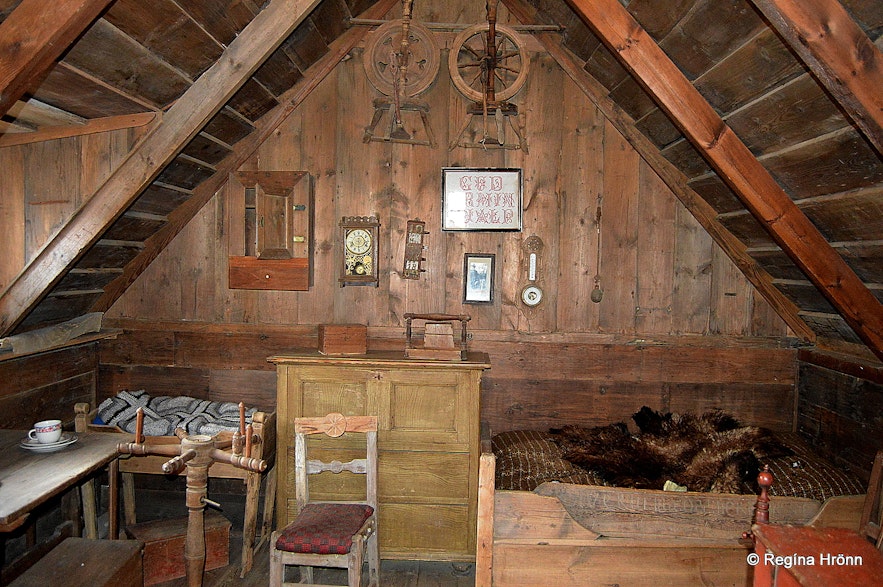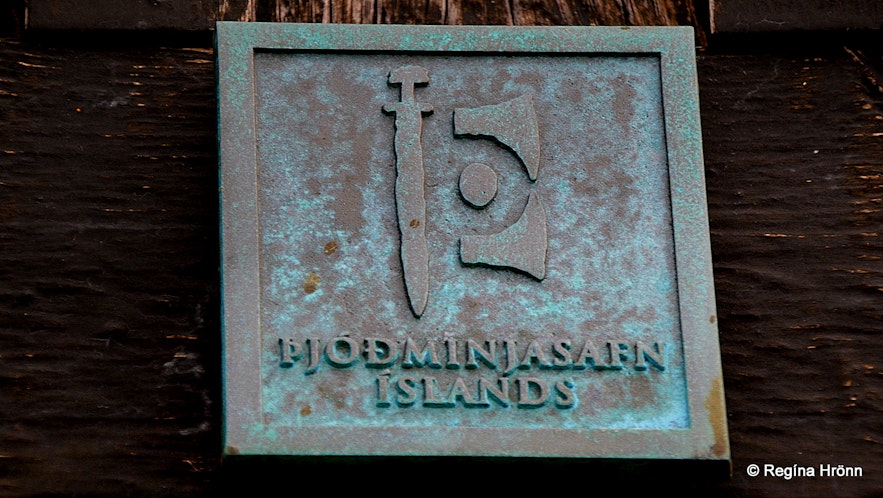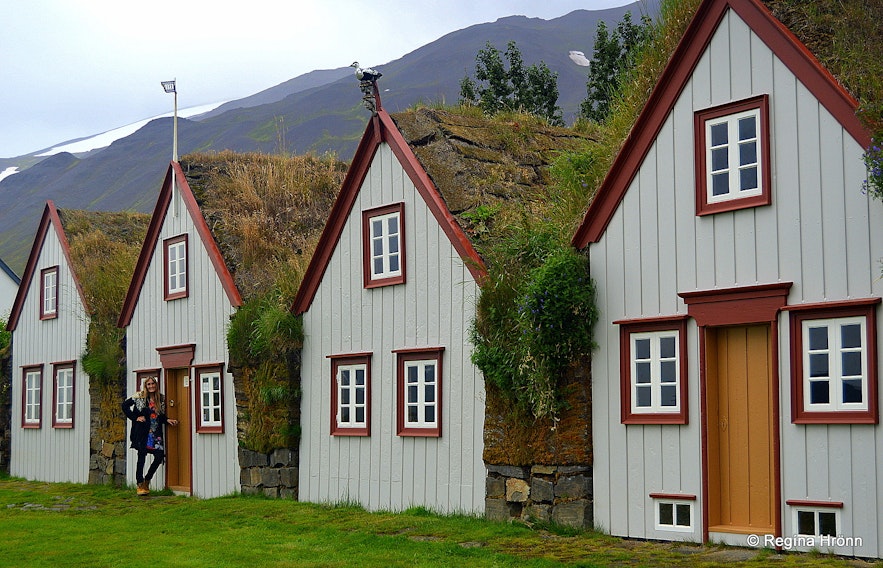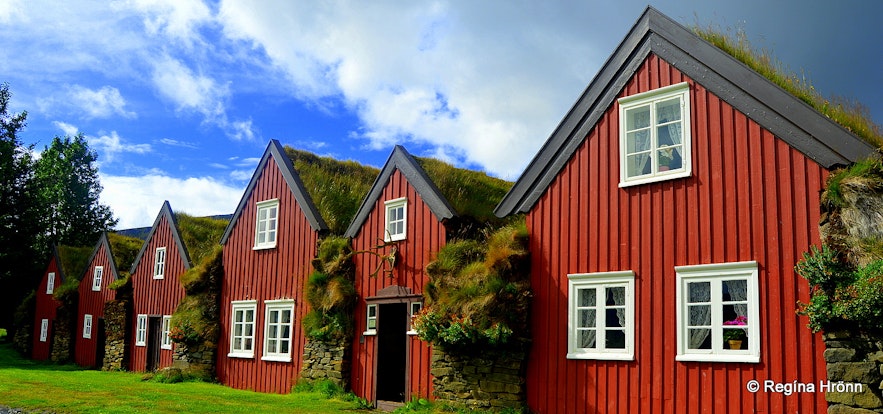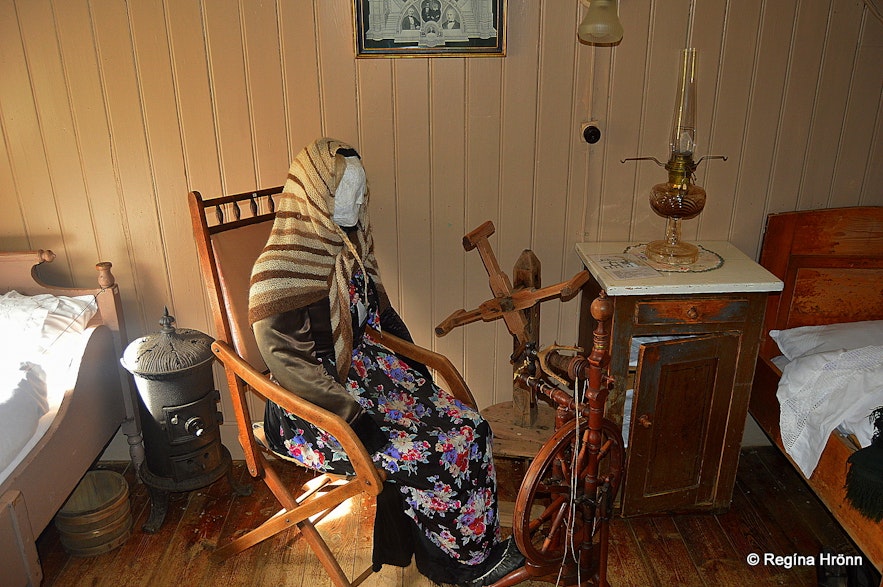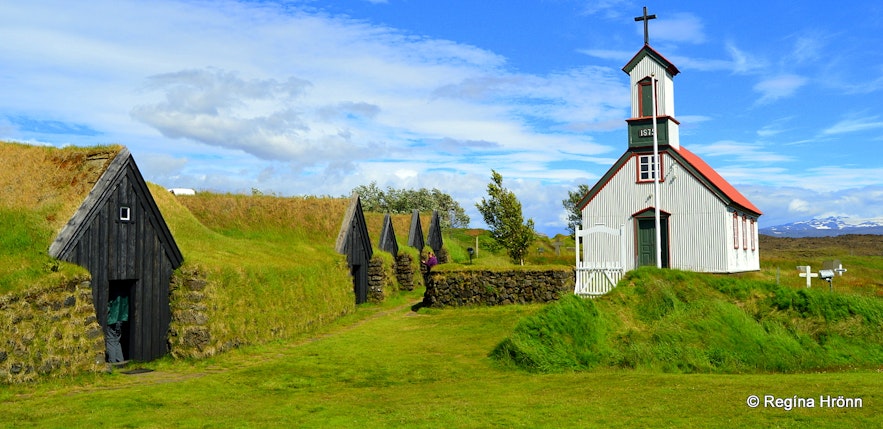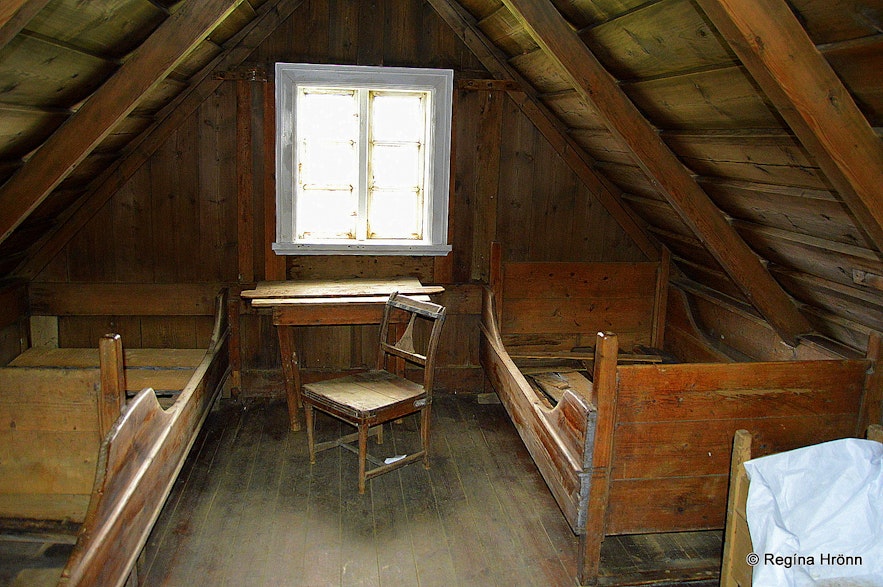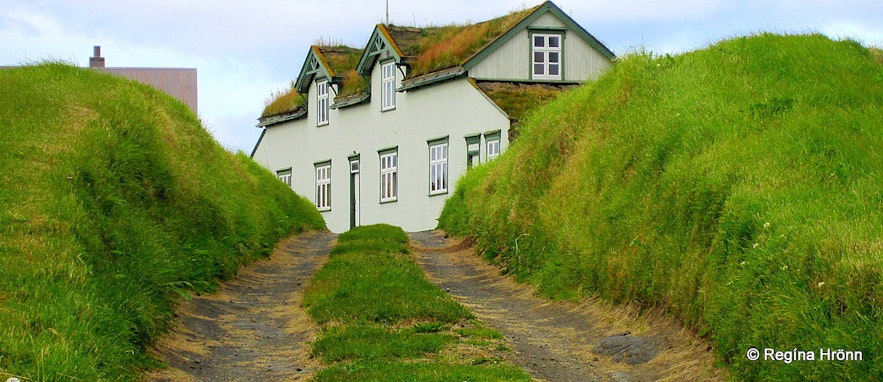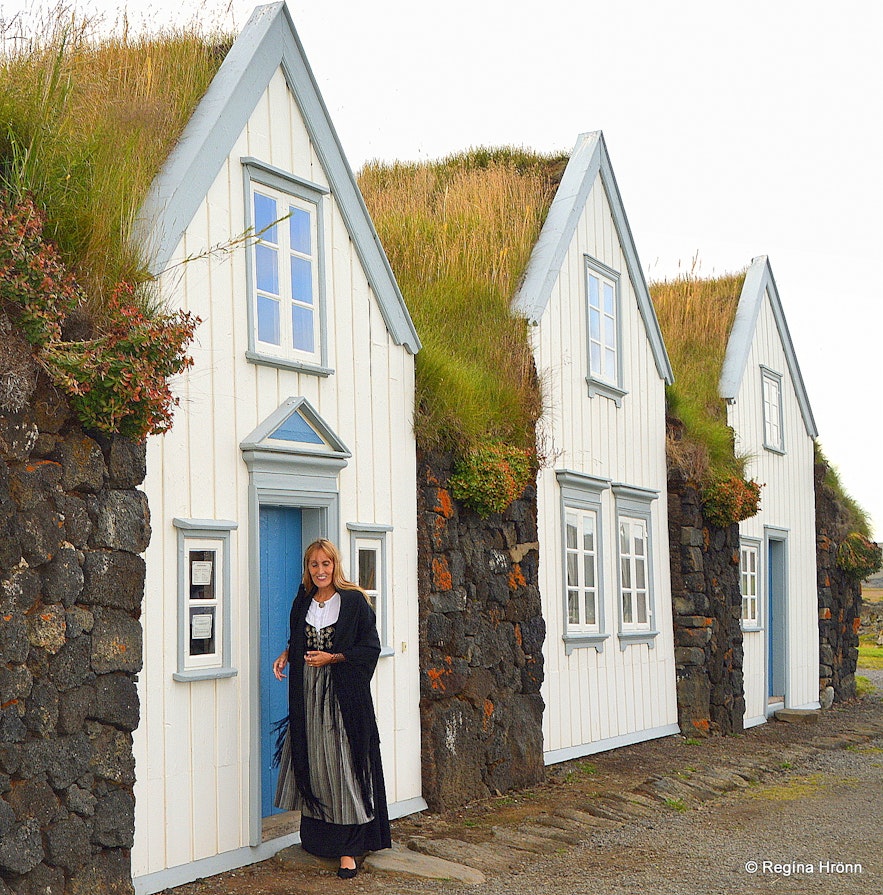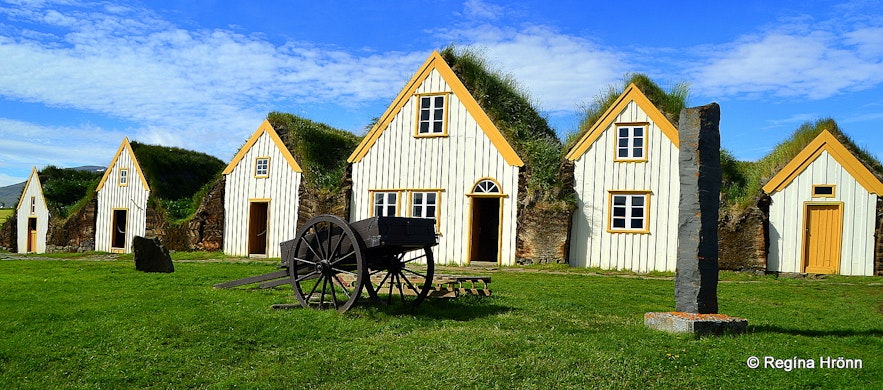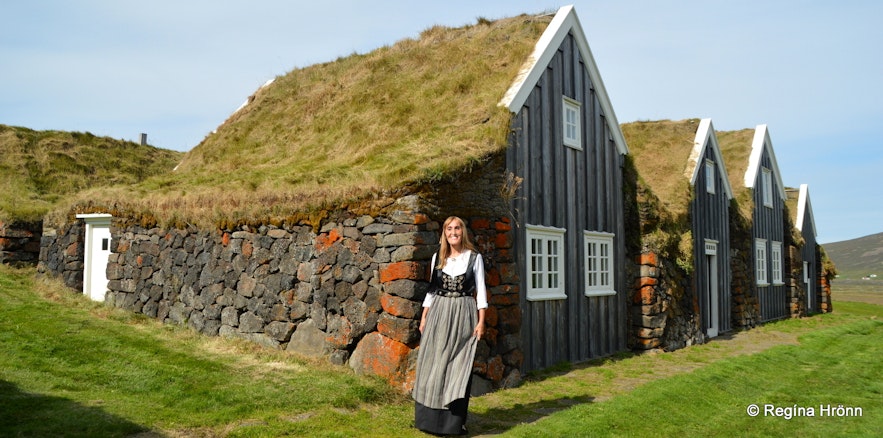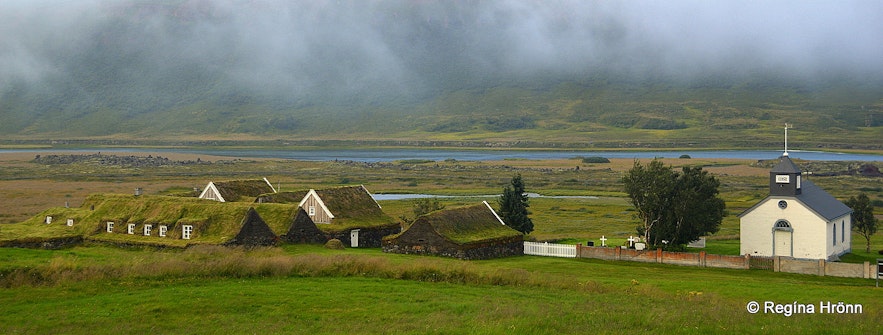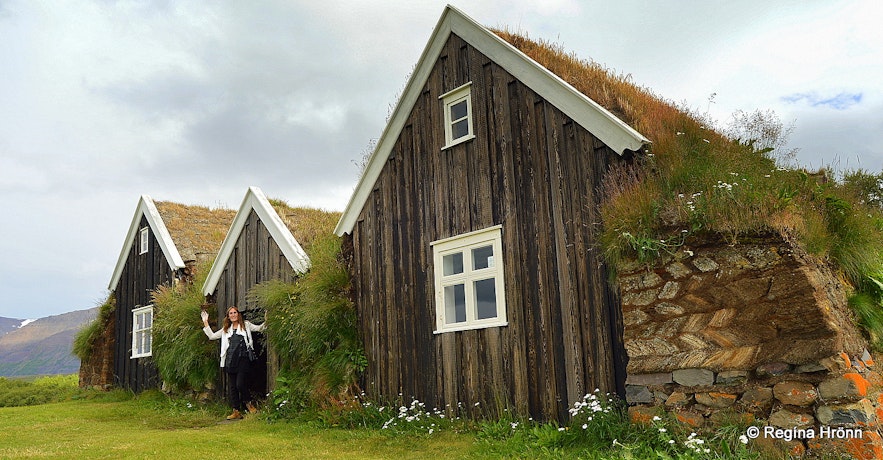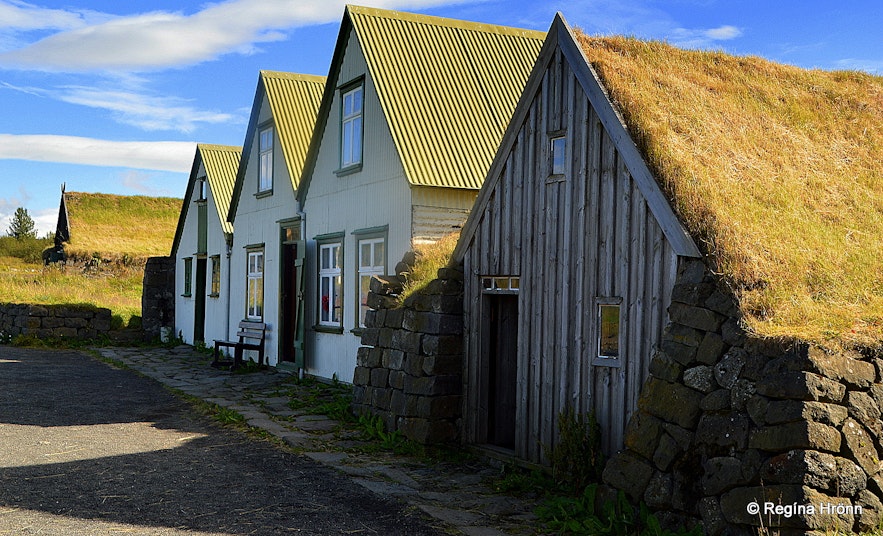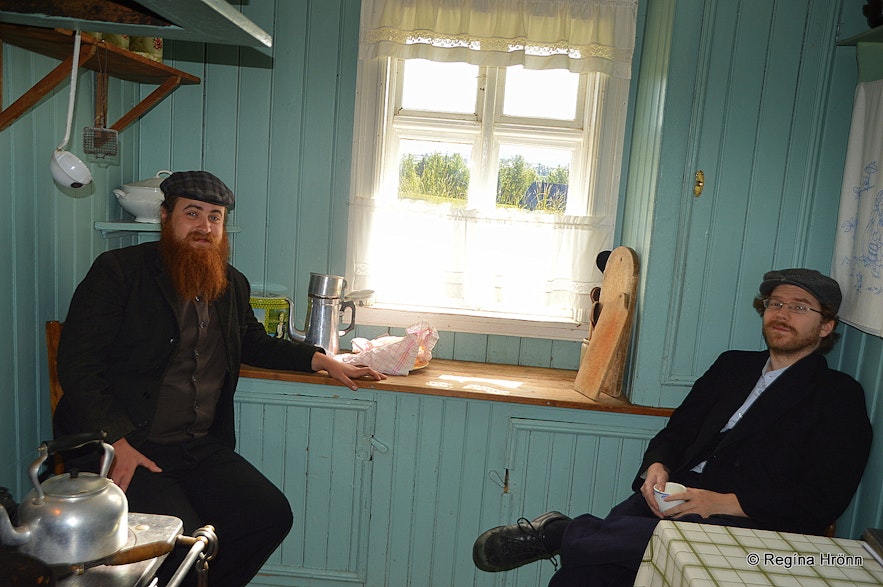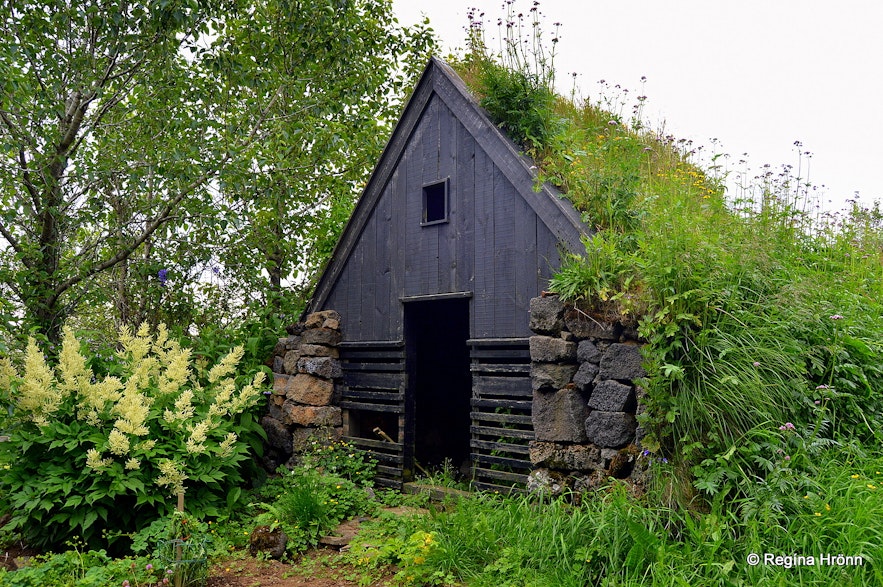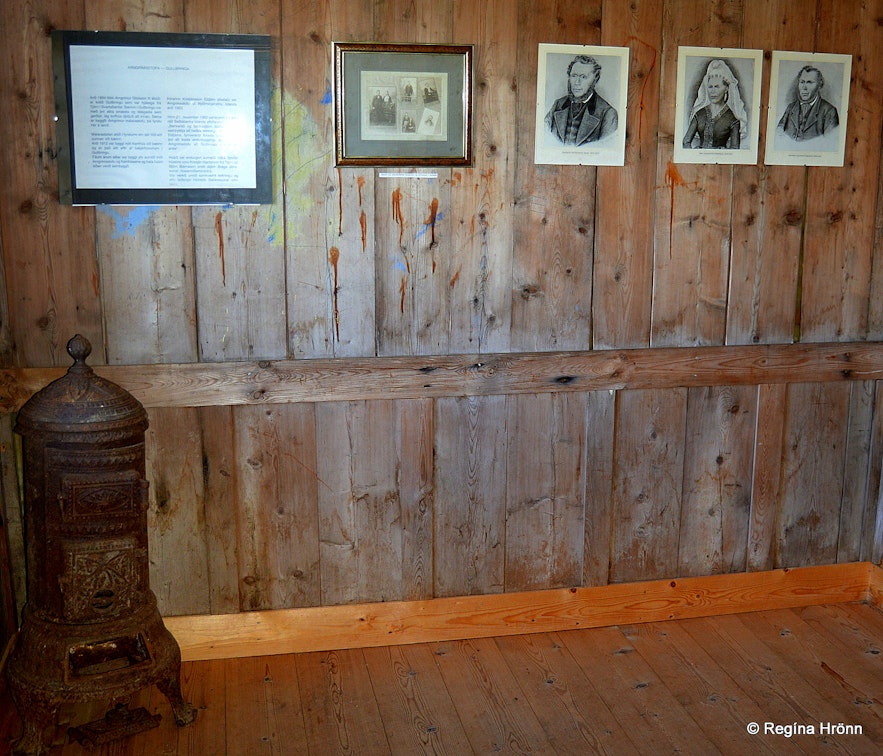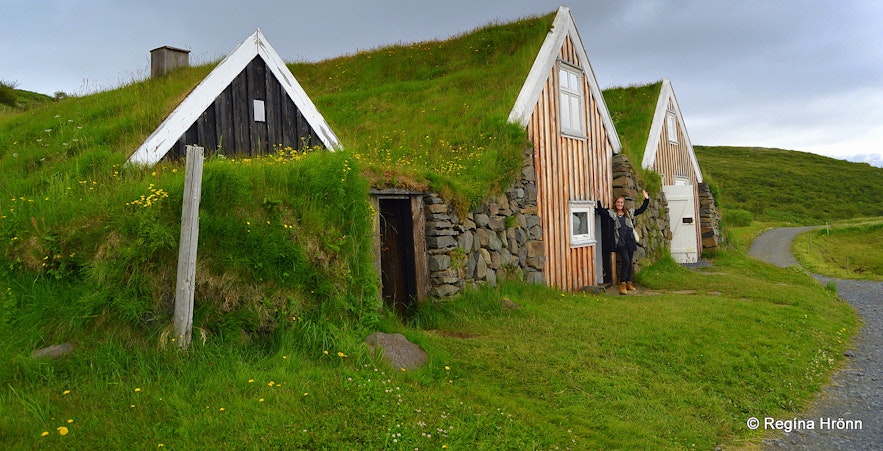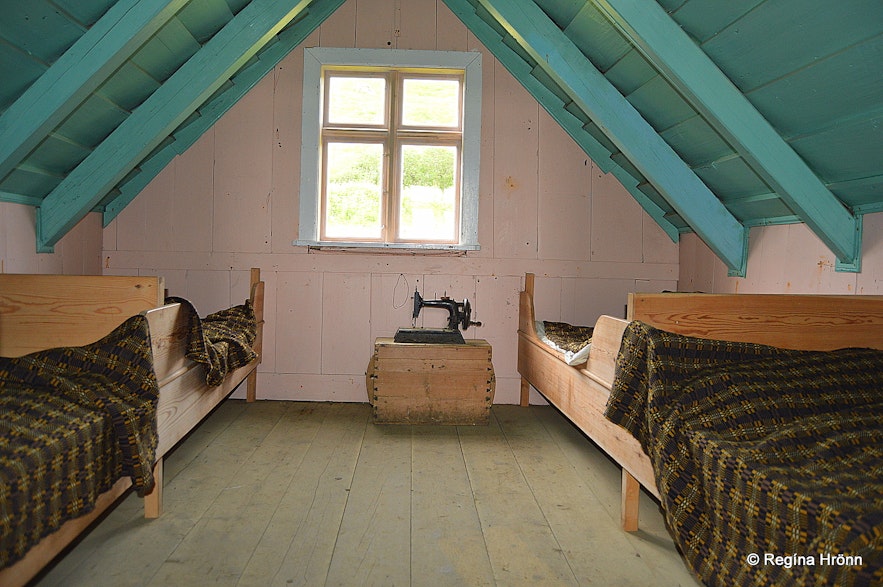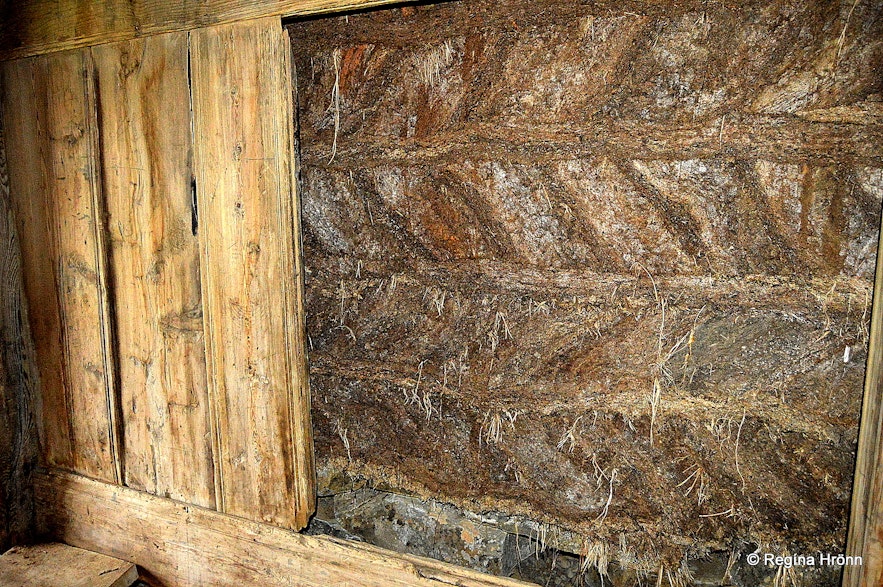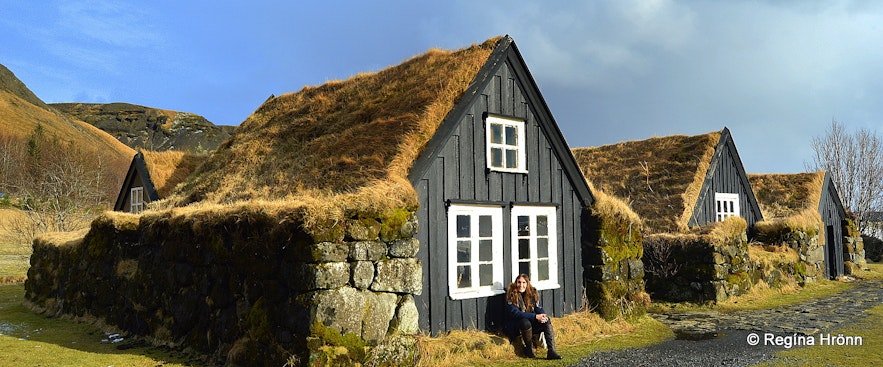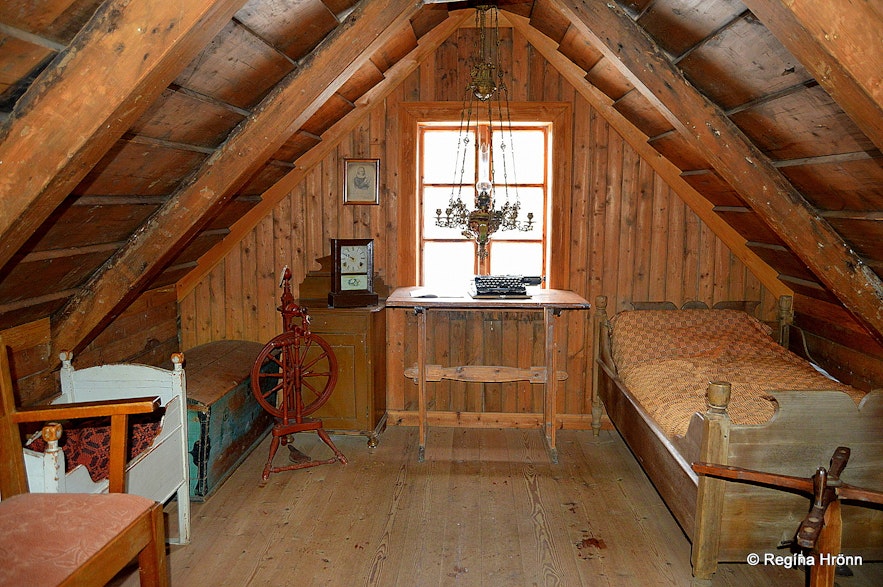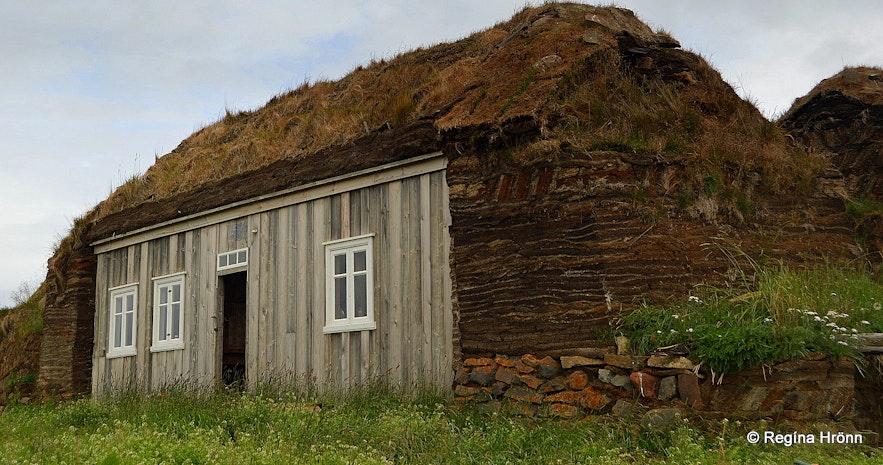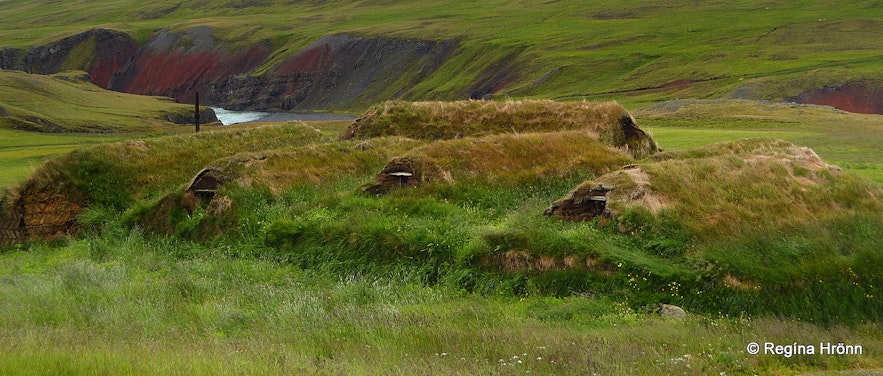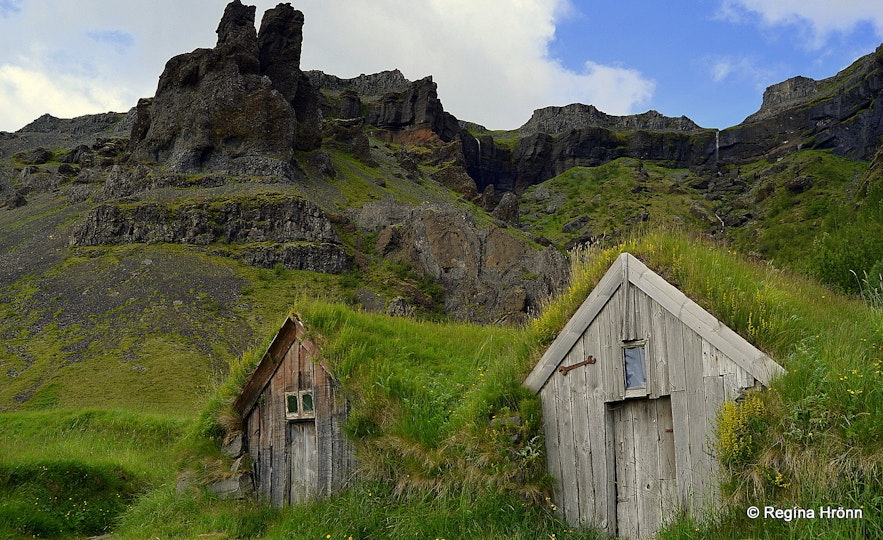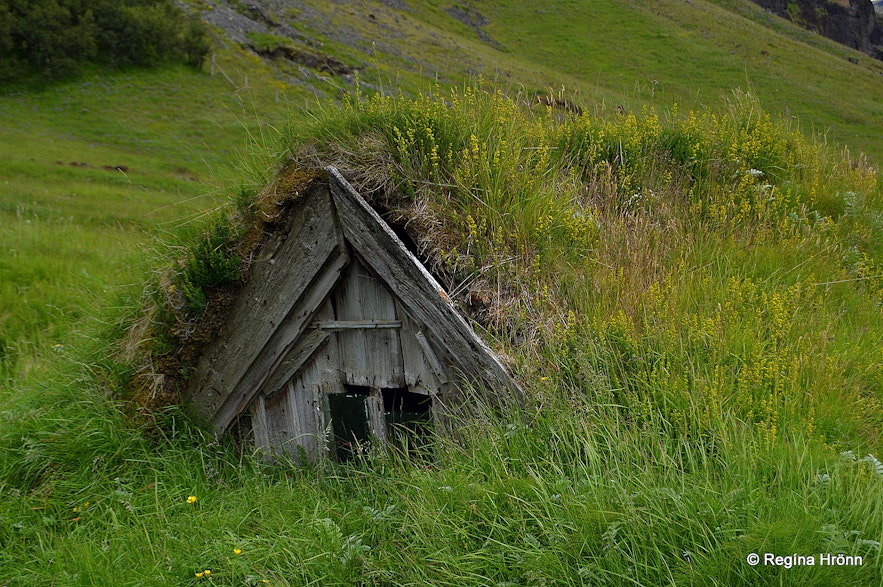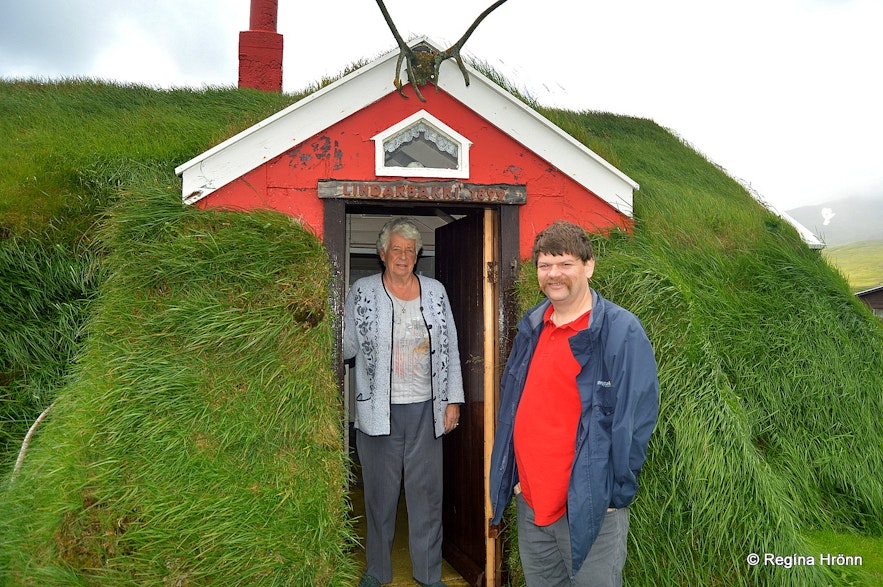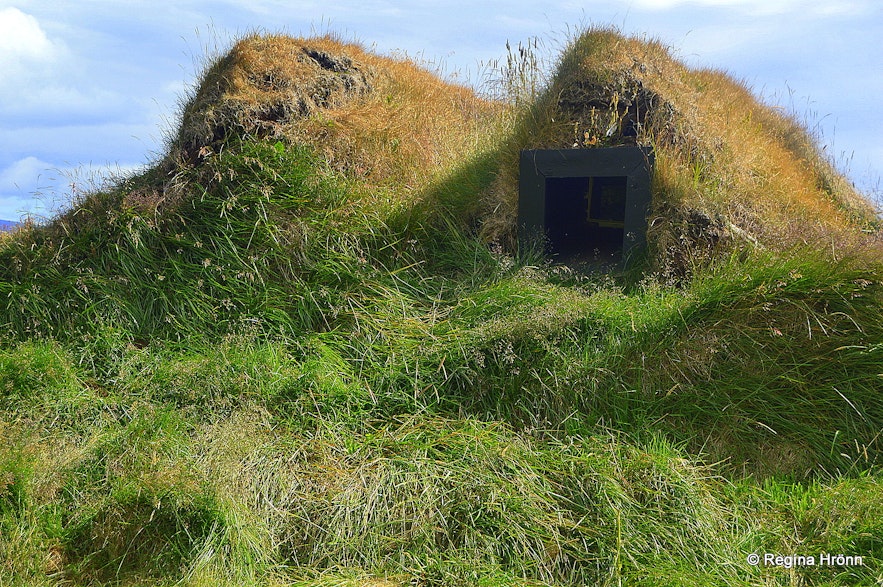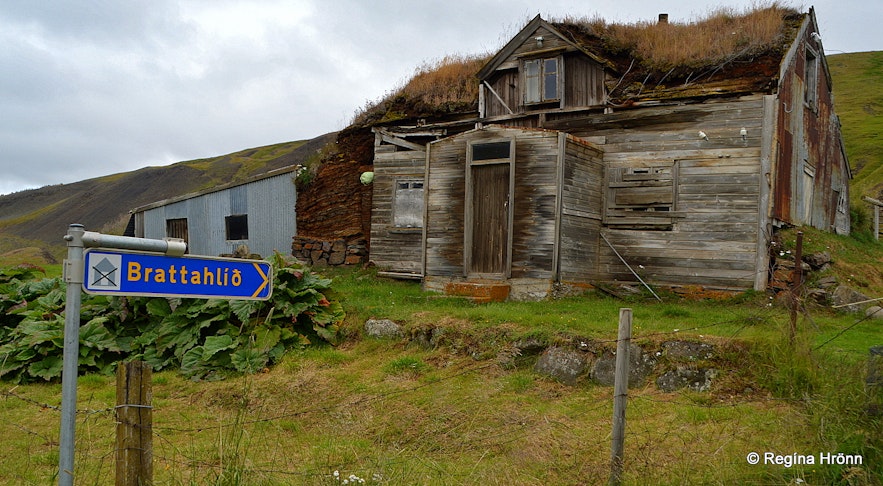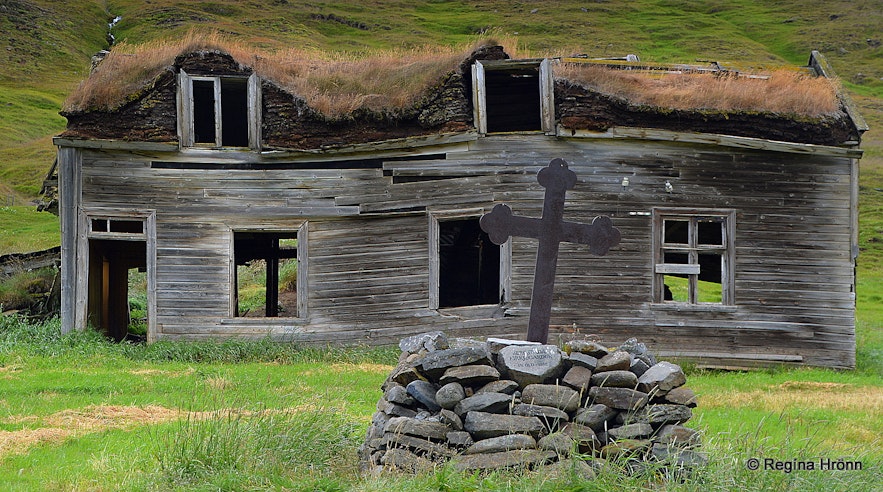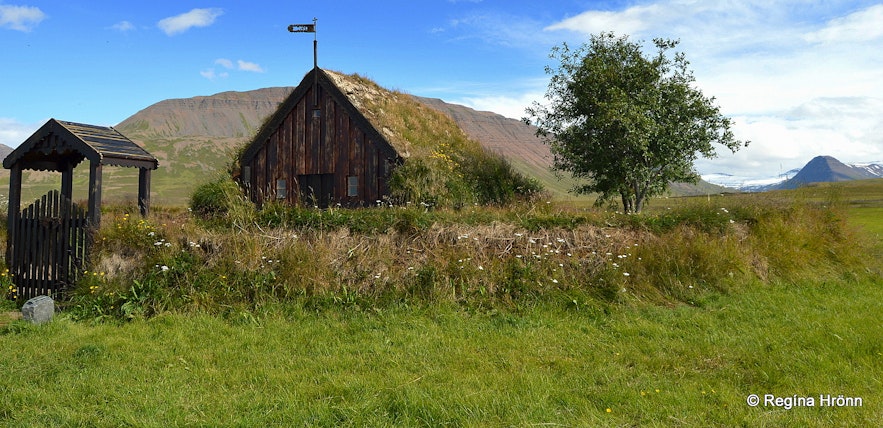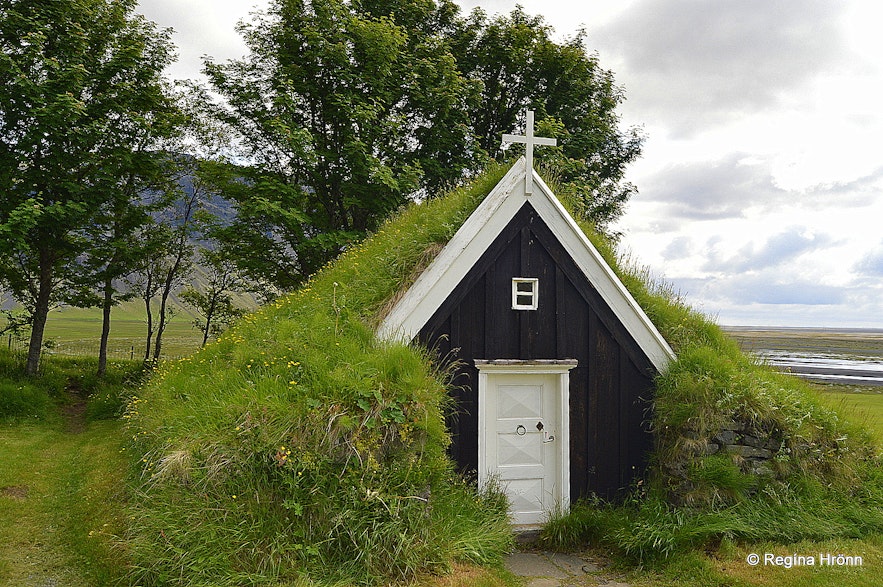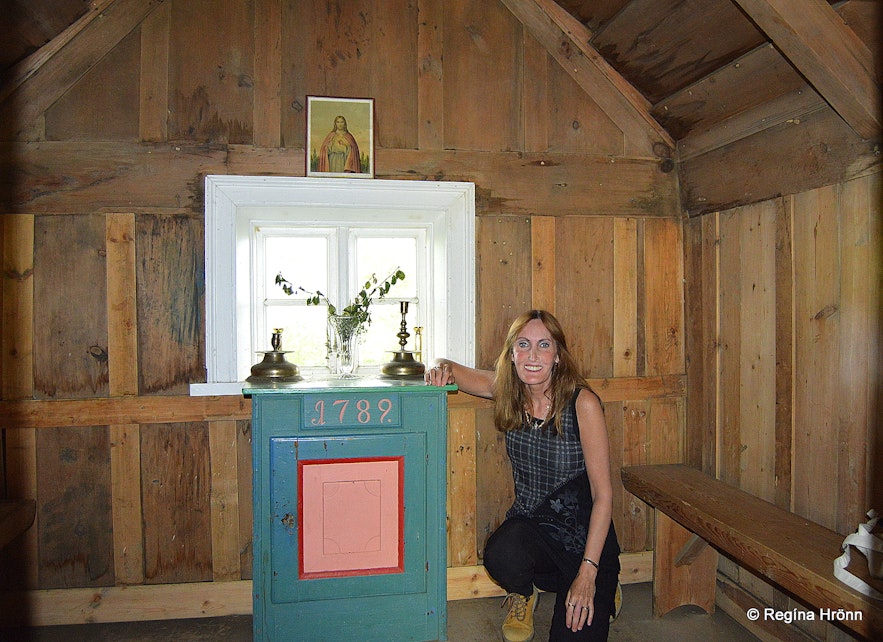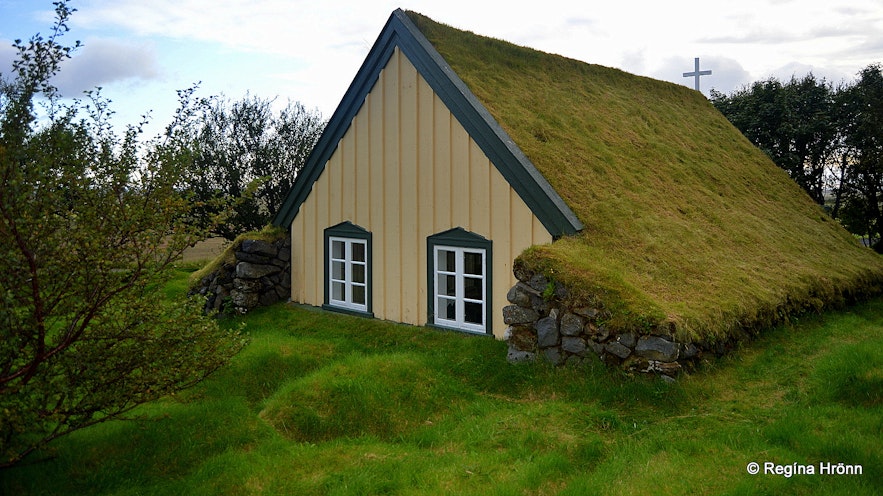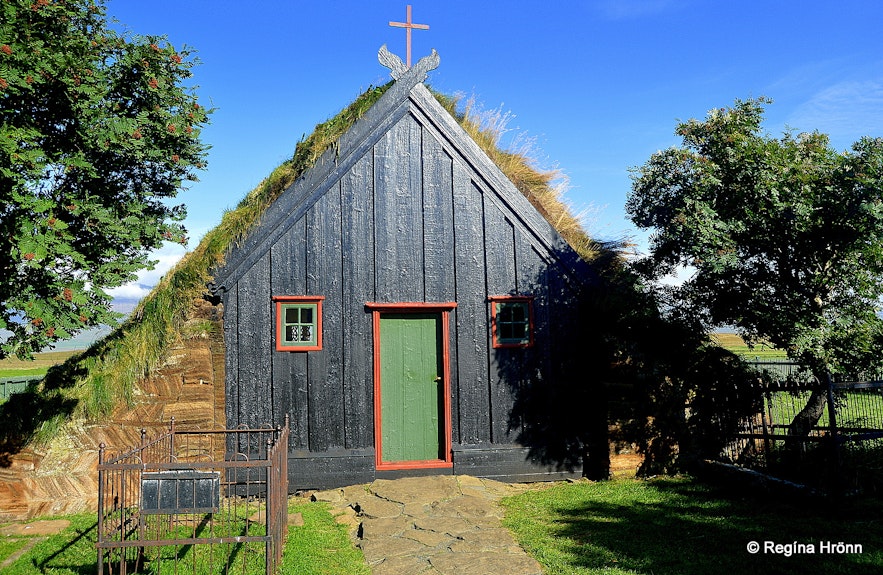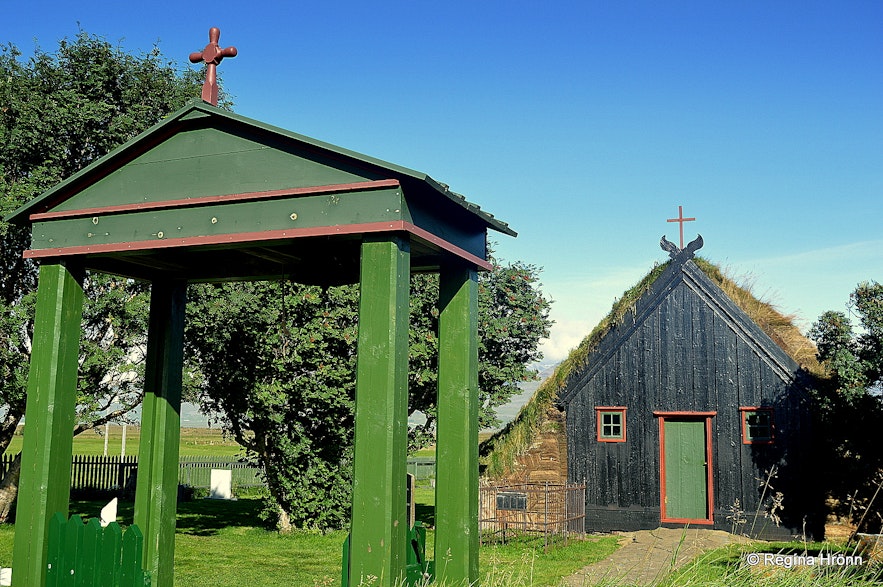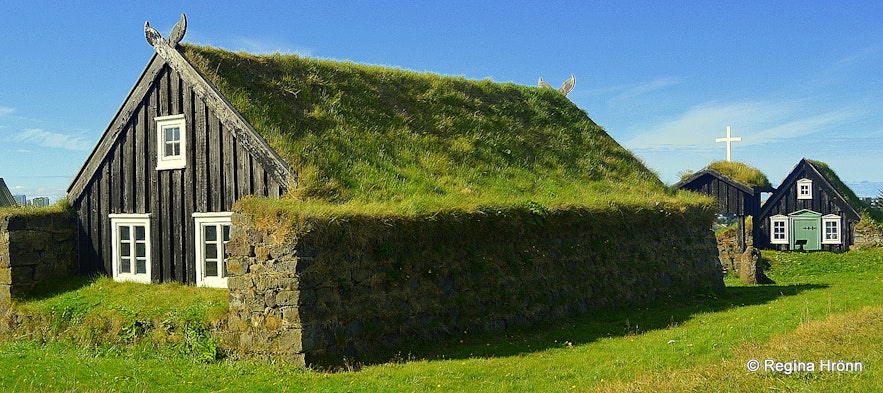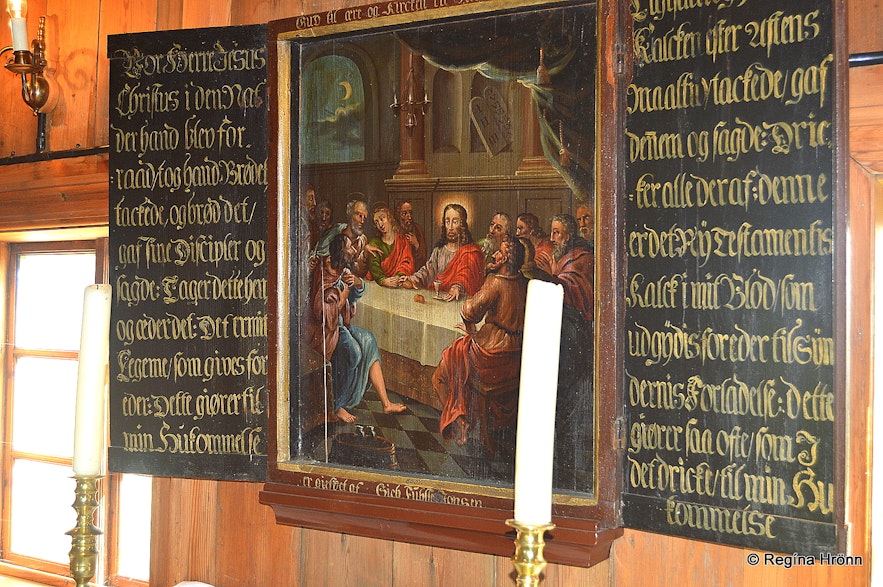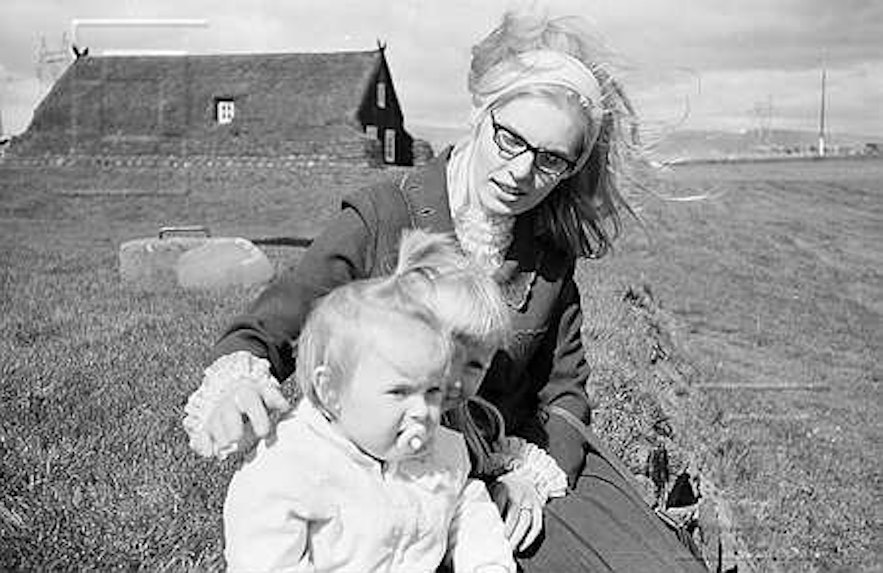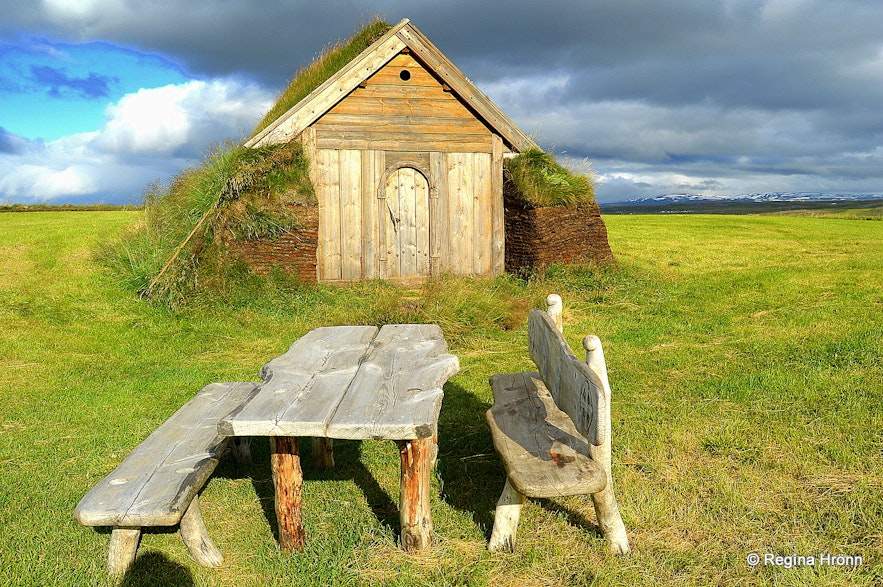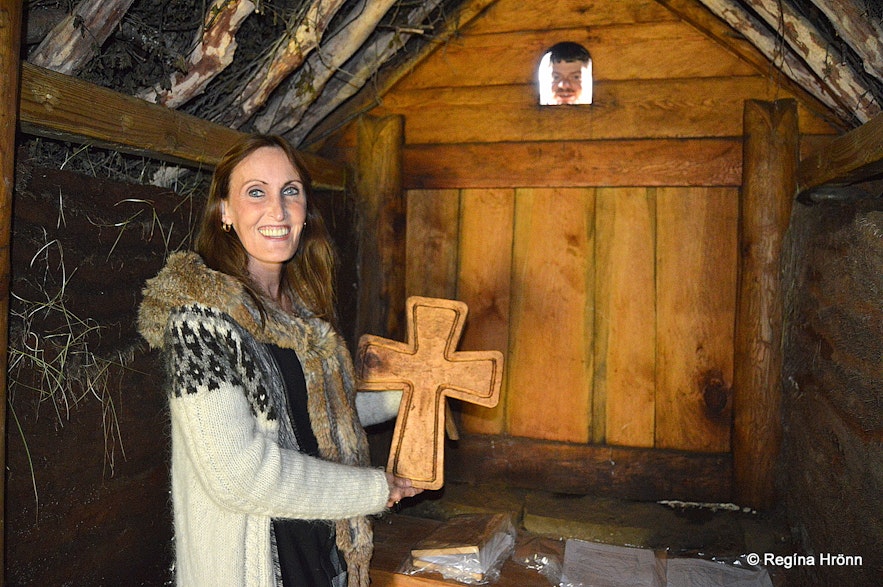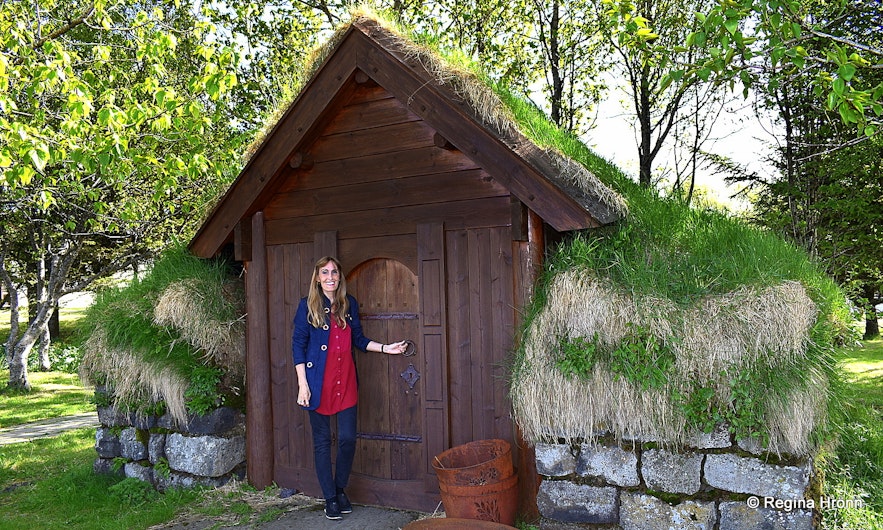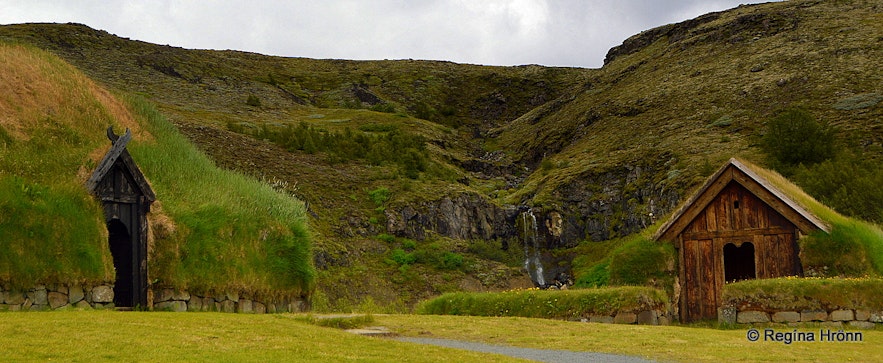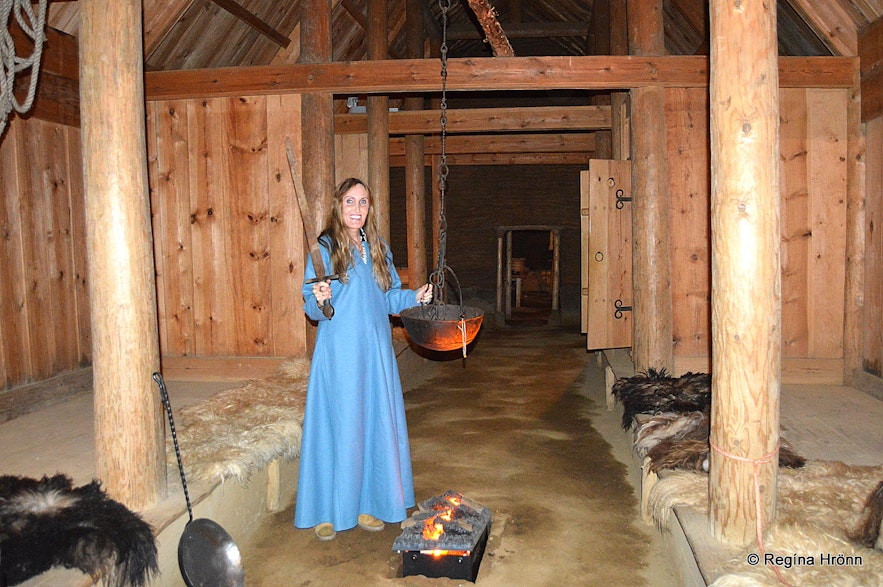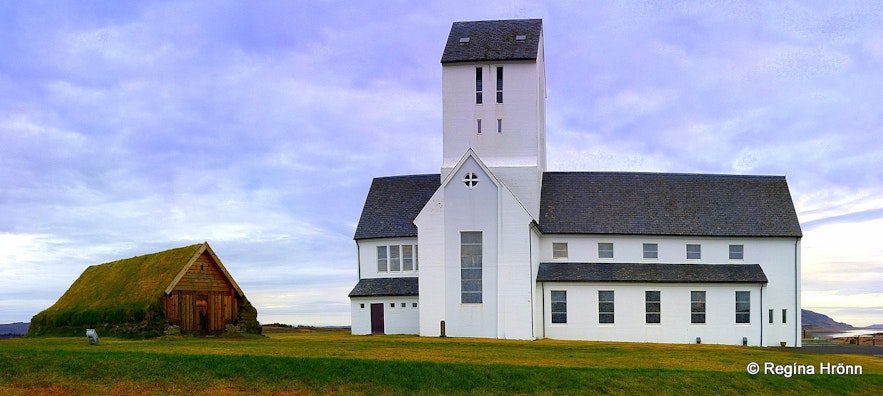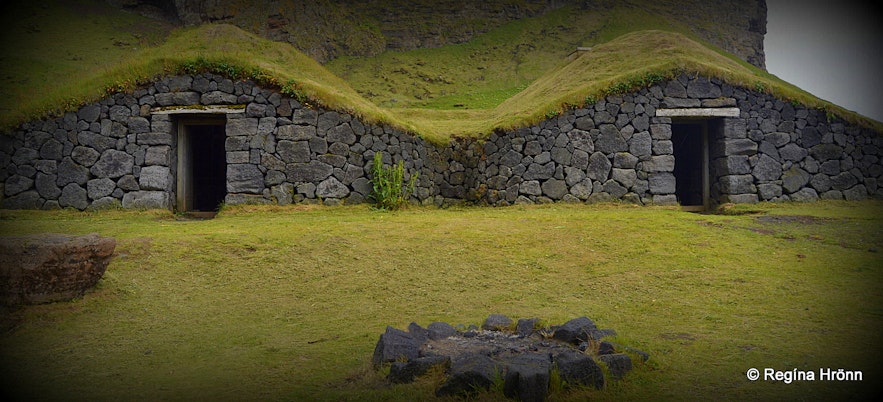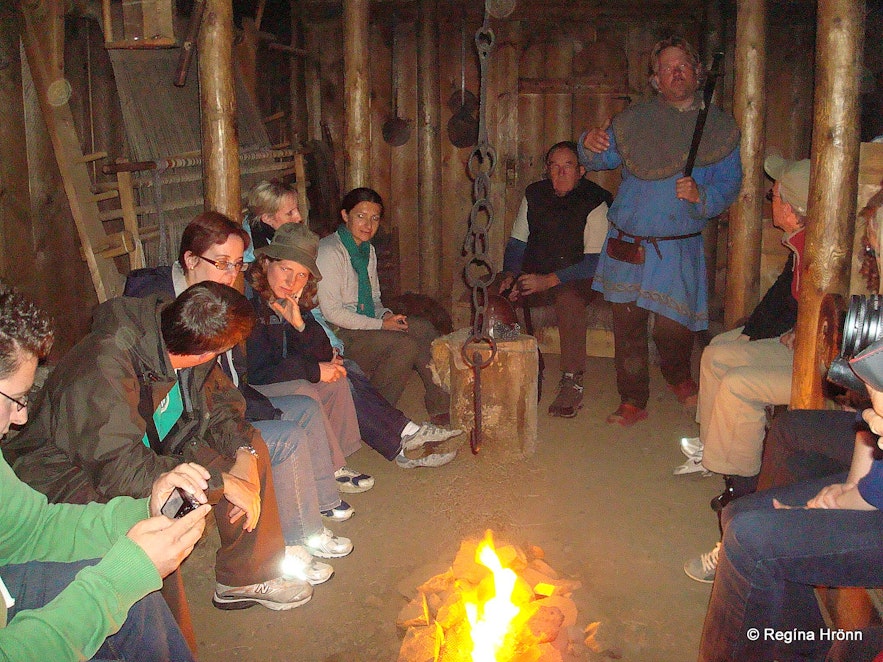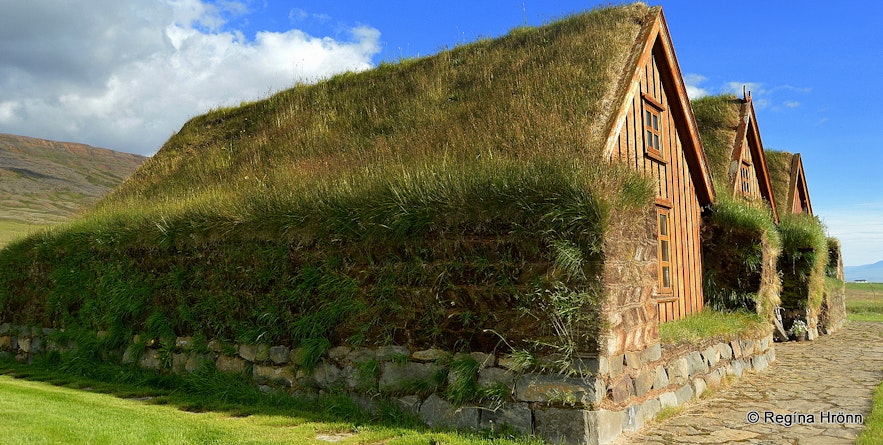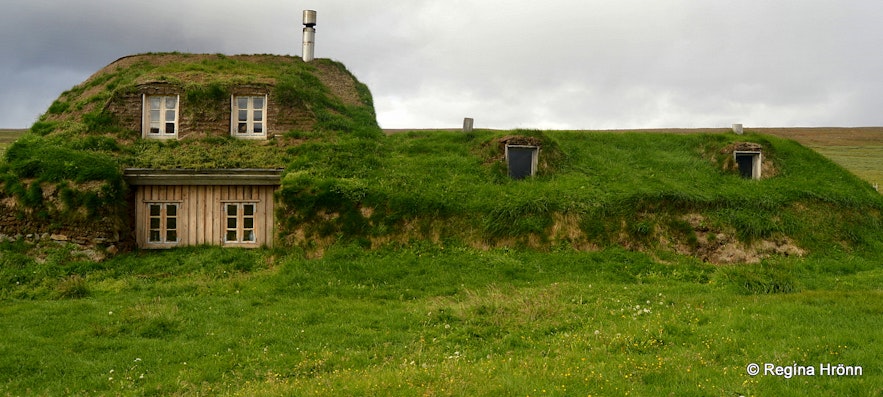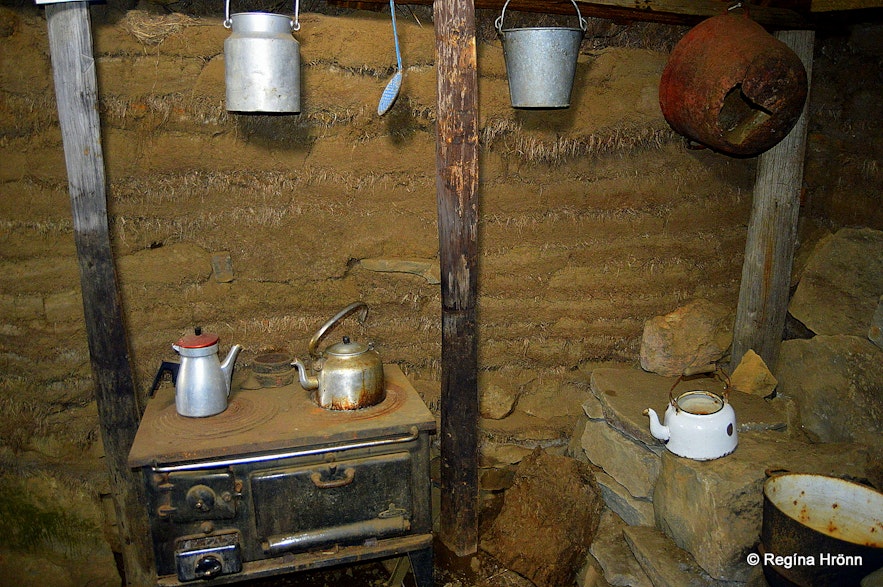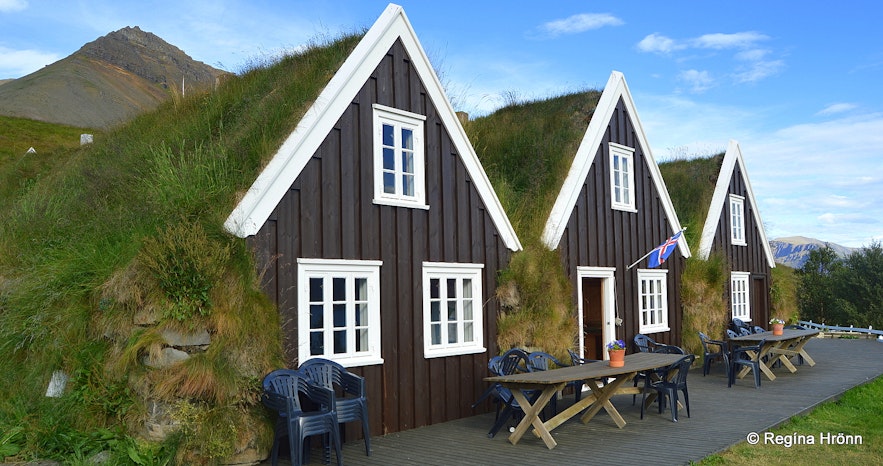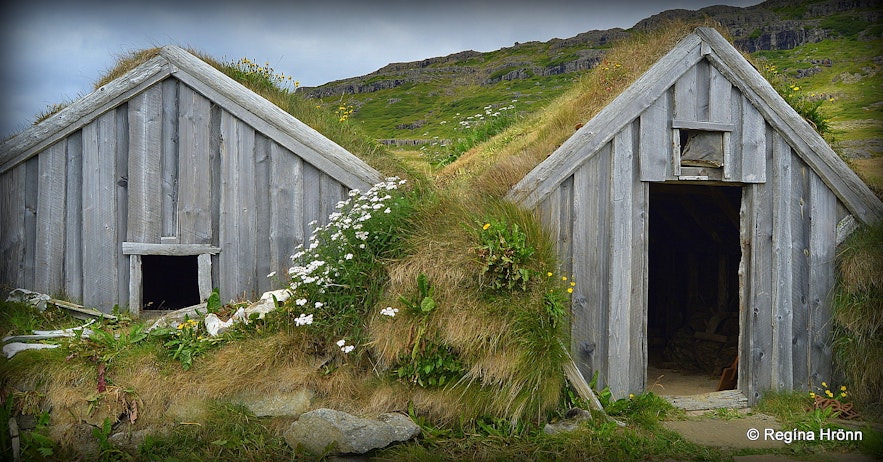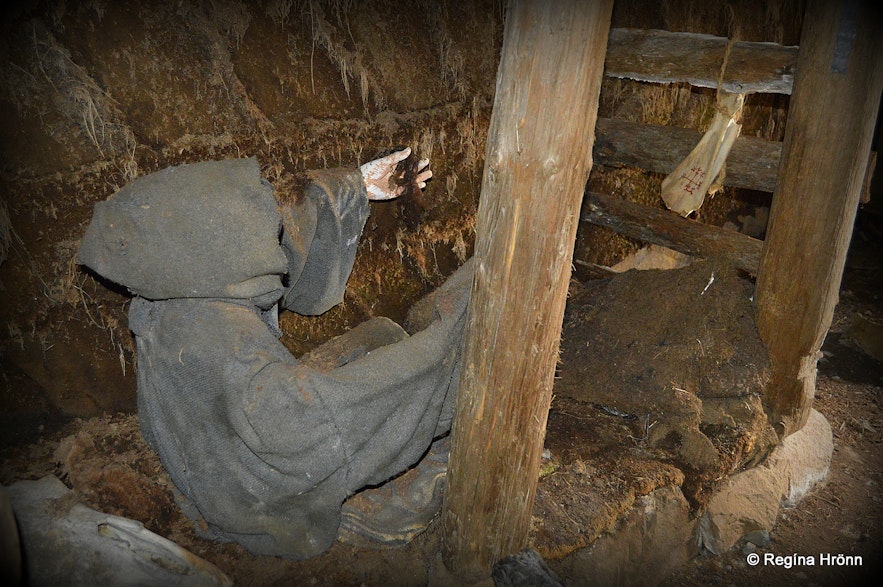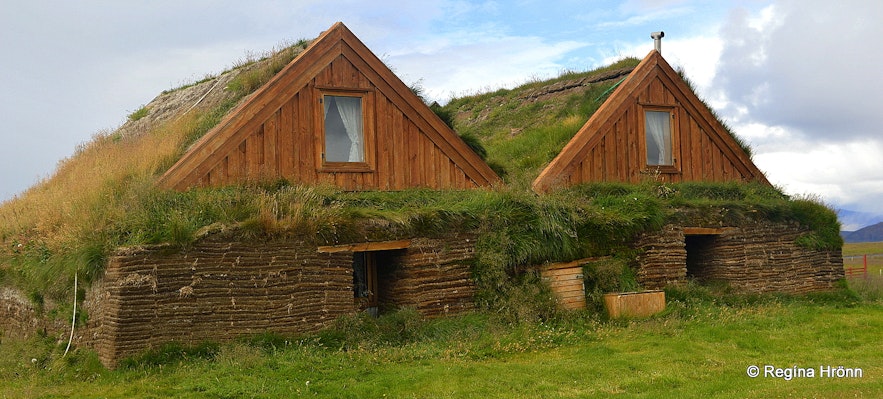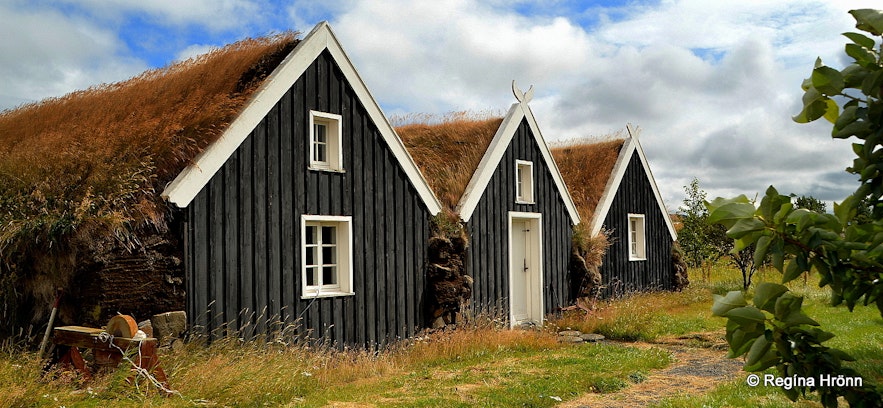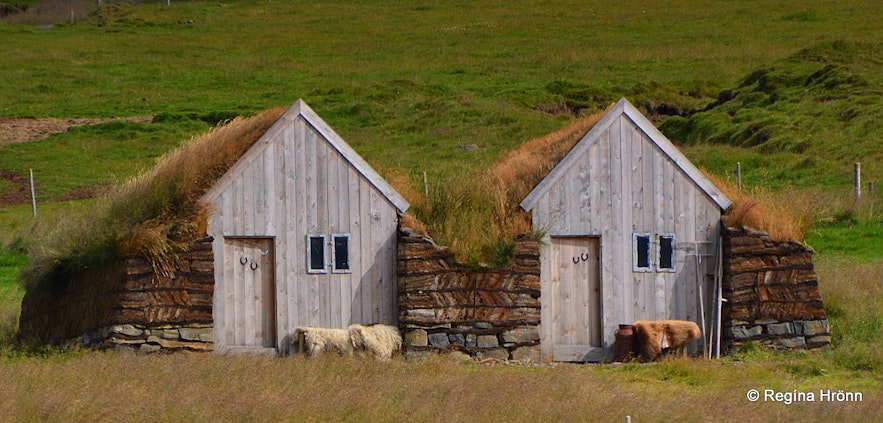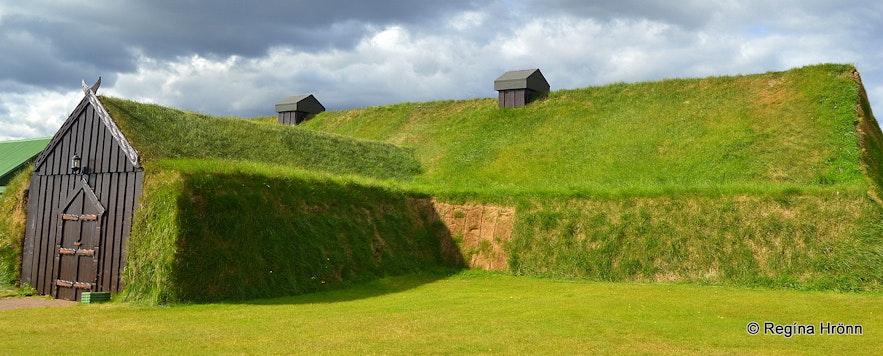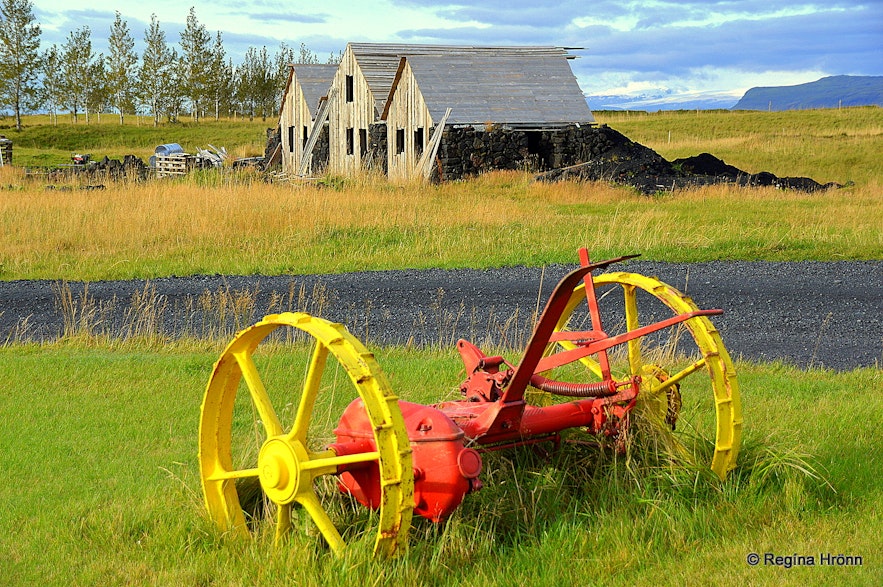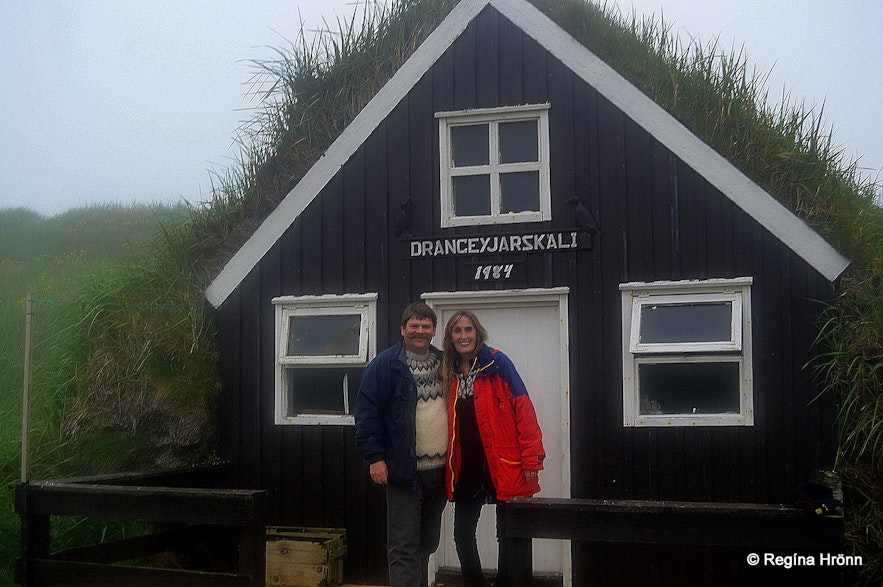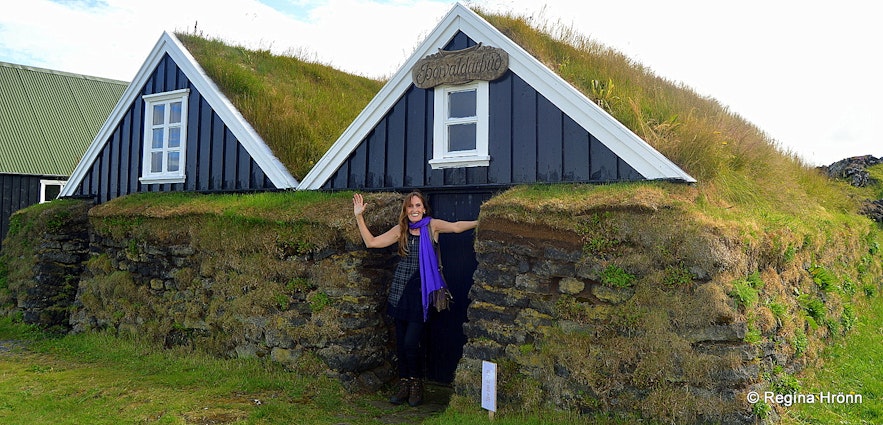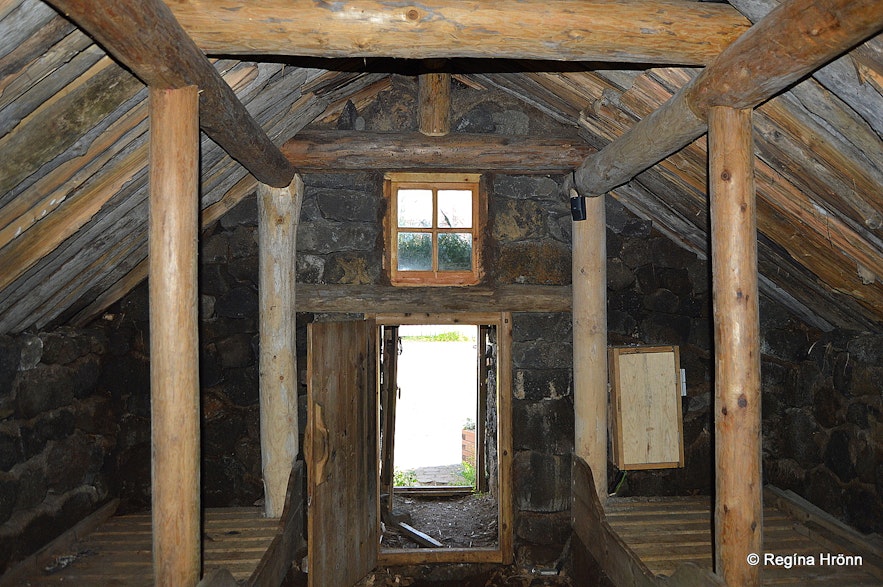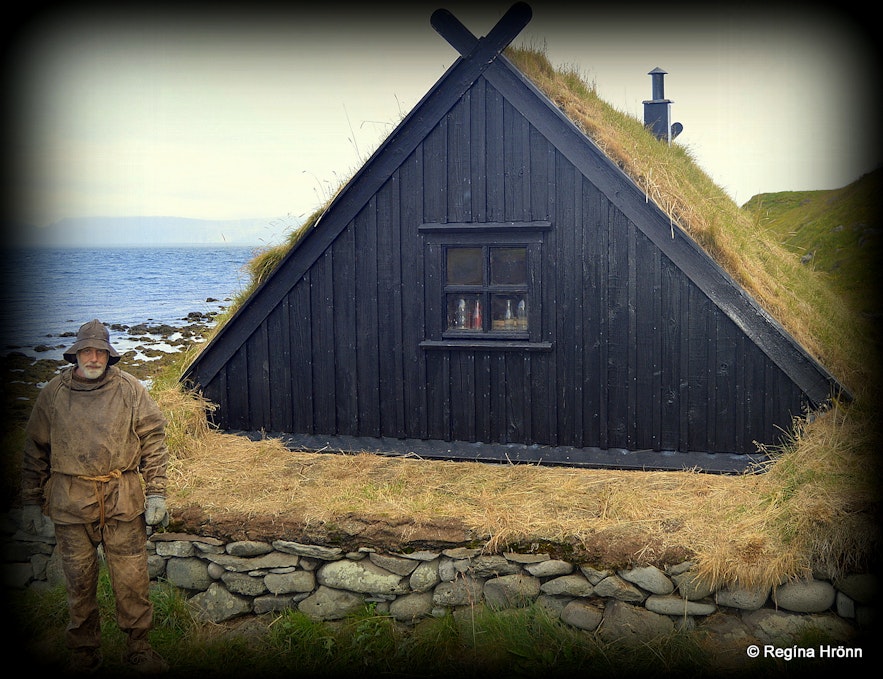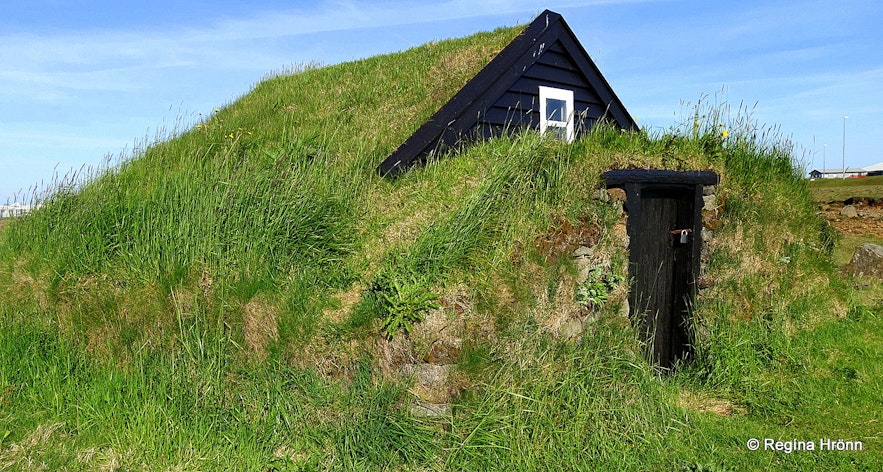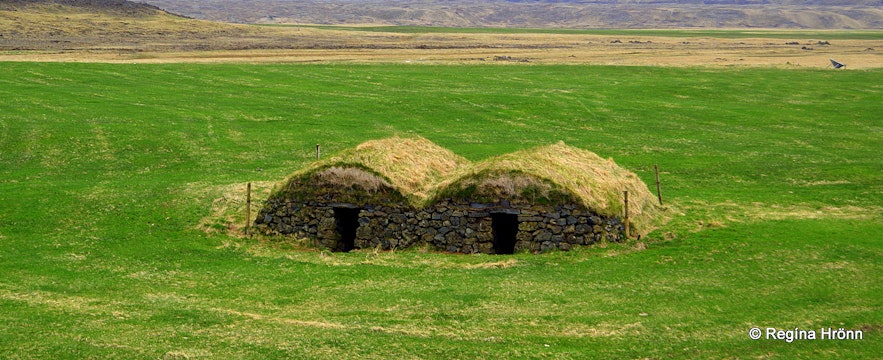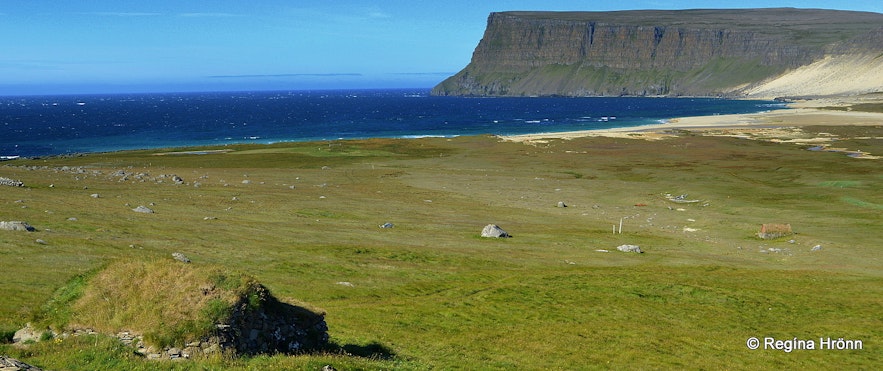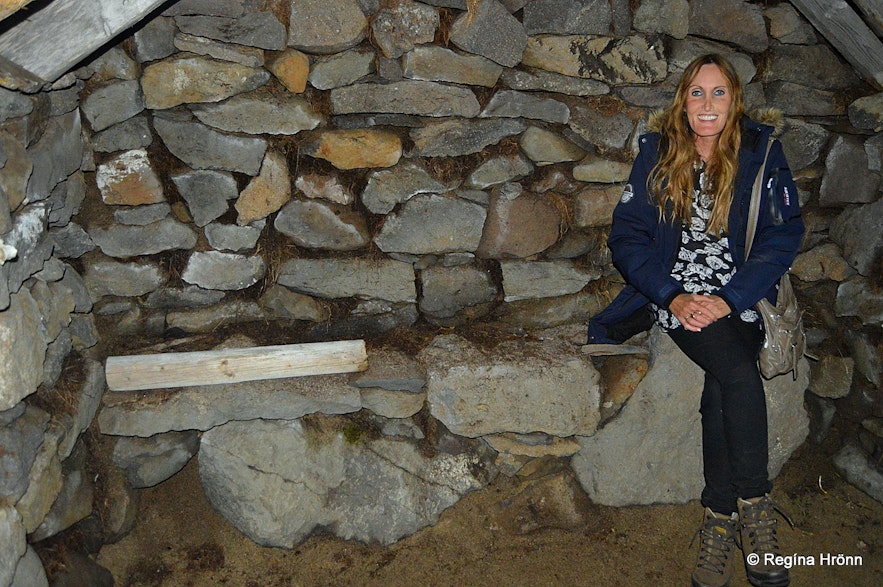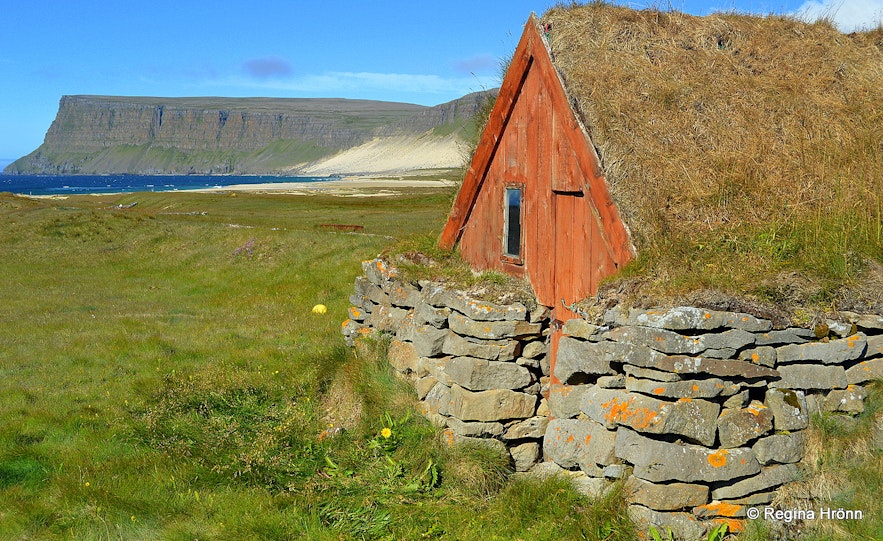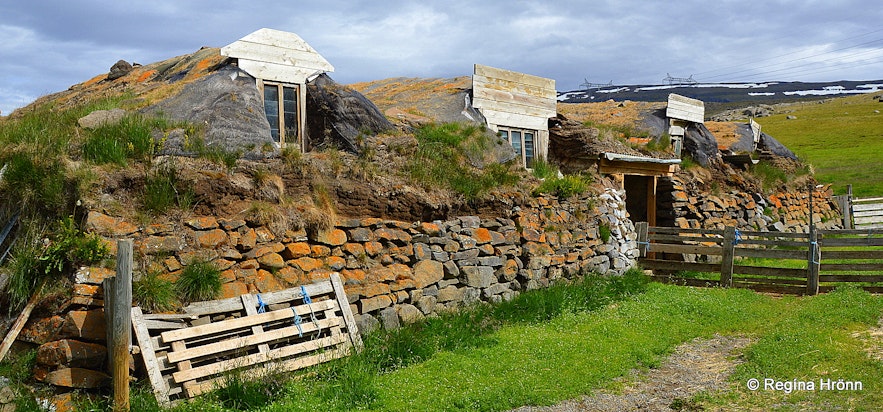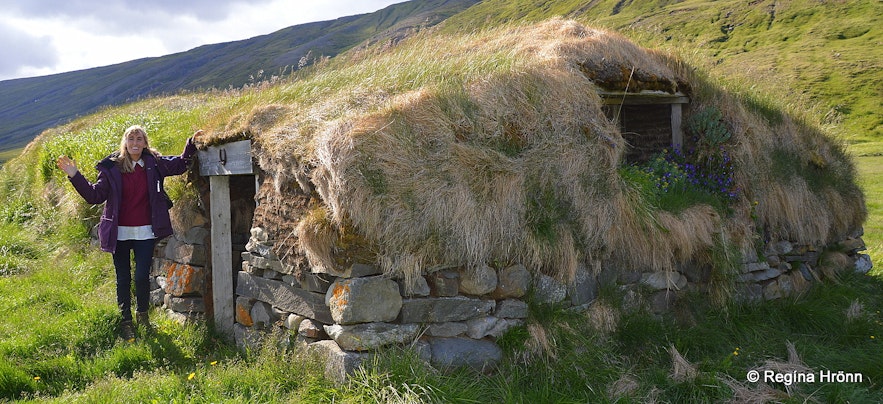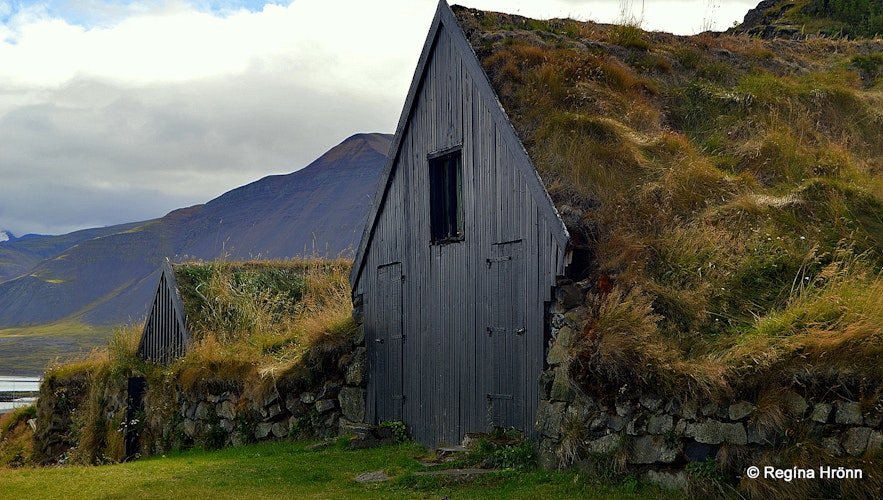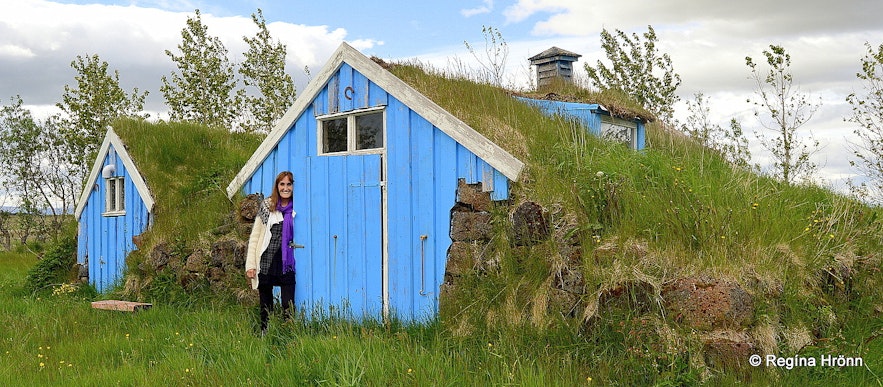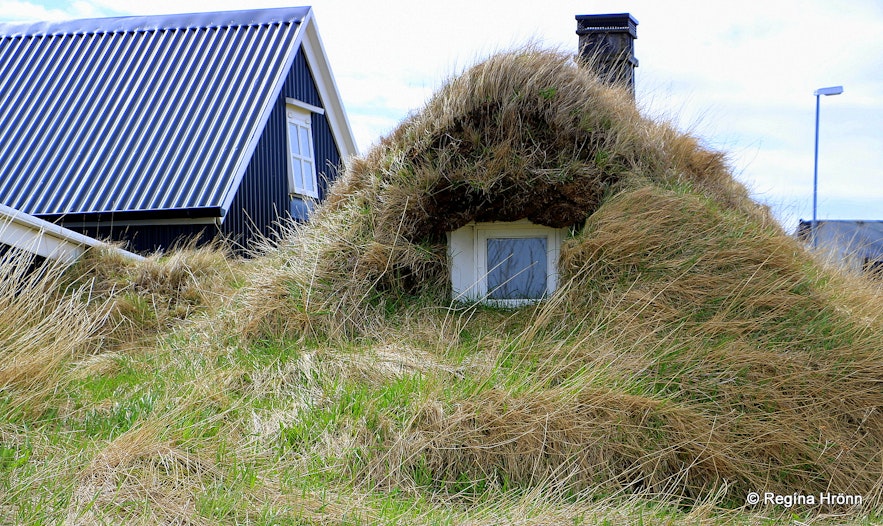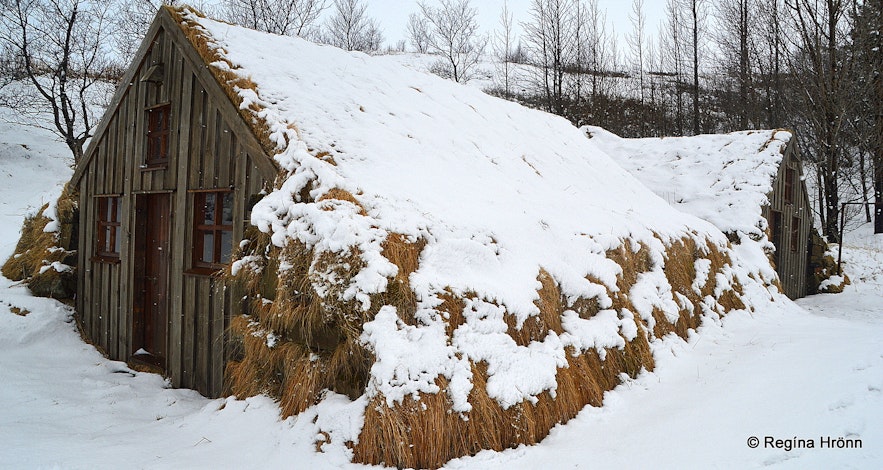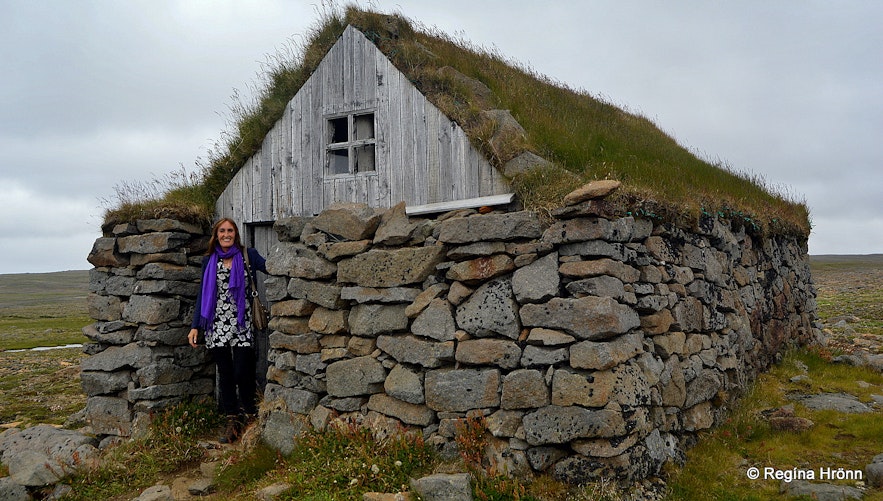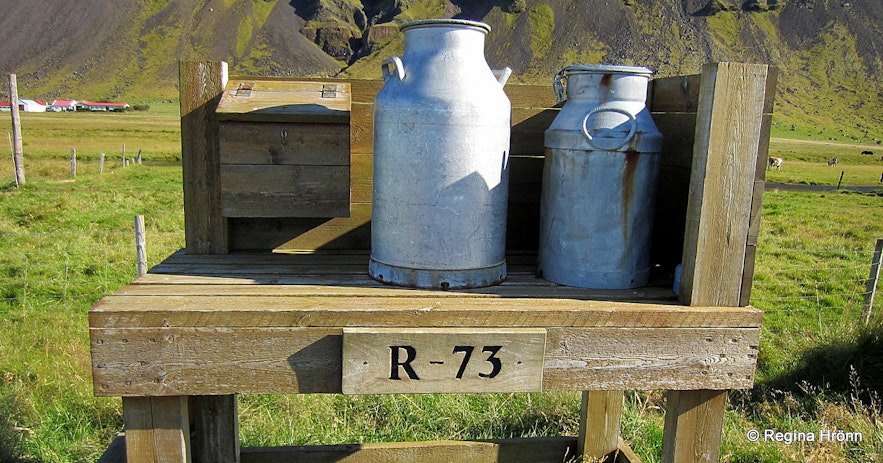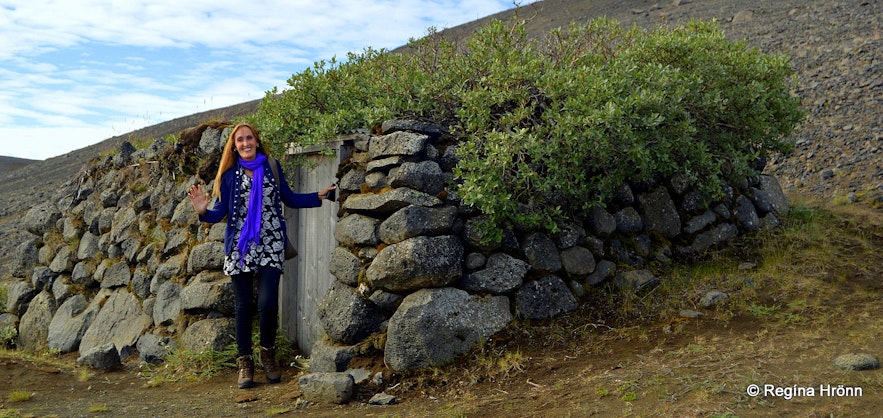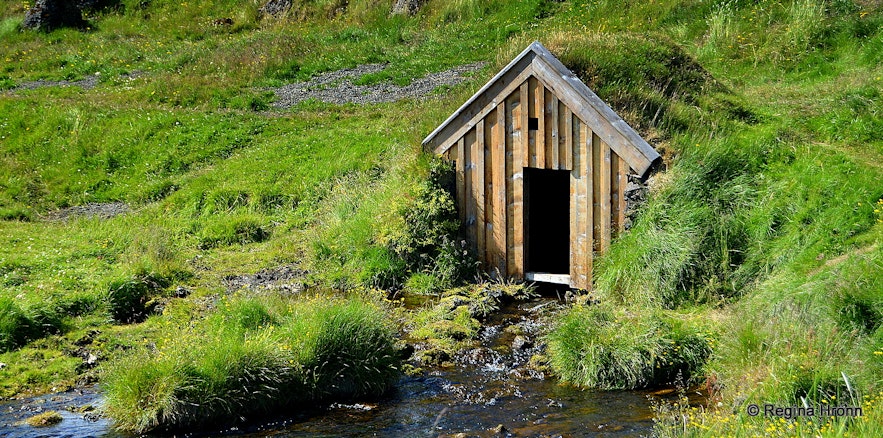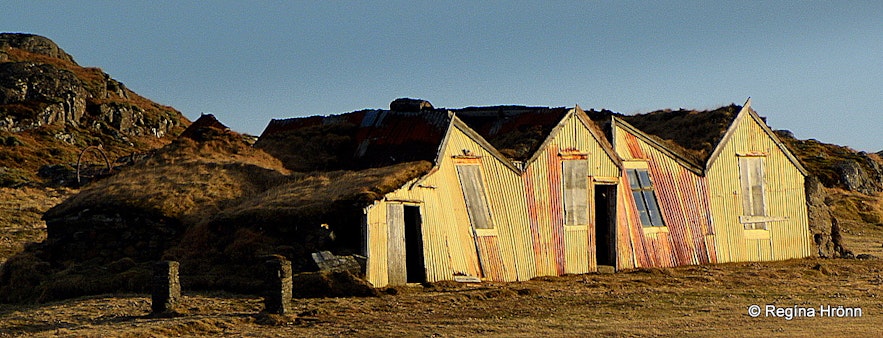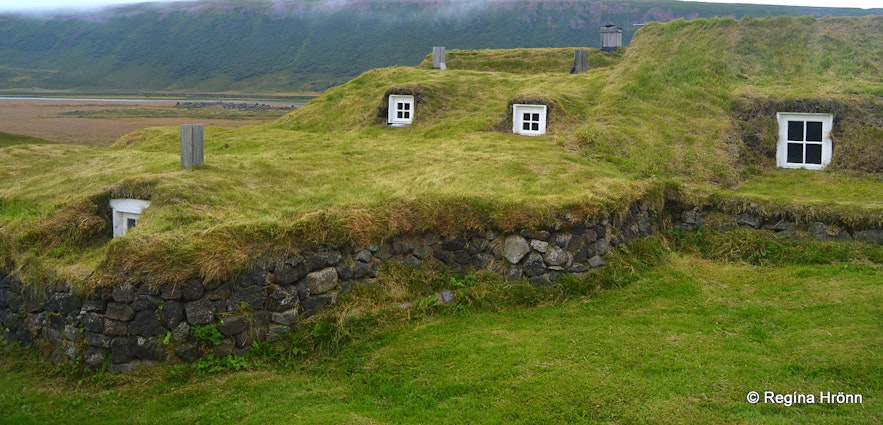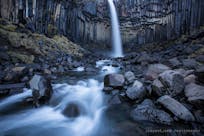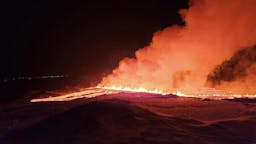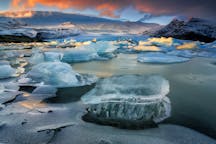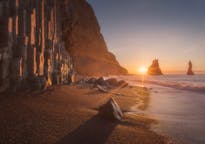
A List of the beautiful Icelandic Turf Houses, I have visited on my Travels in Iceland
- The "Original" Turf Houses in Iceland
- Laufás turf house in North-Iceland
- Bustarfell turf house in East-Iceland
- Keldur turf house in South-Iceland
- Grænavatn turf house at Mývatn in North-Iceland
- Grenjaðarstaður turf house in North-Iceland
- Glaumbær turf house in Skagafjörður in North-Iceland
- Þverá turf house in Laxárdalur valley in North-Iceland
- Nýibær turf house at Hólar in Hjaltadalur in North-Iceland
- Árbær turf house in Reykjavík in South-West Iceland
- Stóru-Akrar turf house in Skagafjörður in North-Iceland
- Íslenski bærinn turf house at Austur-Meðalholt in South-Iceland
- Arngrímsstofa turf house in Svarfaðardalur in North-Iceland
- Selið turf house in Skaftafell in South-Iceland
- Reynistaður turf house in Skagafjörður in North-Iceland
- Skógar turf houses in South-Iceland
- Galtastaðir-fram turf house in East-Iceland
- Tyrfingsstaðir turf house in North-Iceland
- Núpsstaður turf house in South-Iceland
- Lindarbakki turf house in East-Iceland
- Barmar turf house in Reykhólasveit
- Brattahlíð & Bergsstaðir in Svartárdalur valley in North-Iceland
- Turf churches in Iceland
- Grafarkirkja turf church - the oldest one of them all
- Núpsstaðakirkja turf church - the smallest one
- Hofskirkja turf church - the newest one
- Saurbæjarkirkja turf church - the biggest one
- Víðimýrarkirkja turf church - the most beautiful one
- Árbæjarkirkja turf church - the rebuilt one
- Geirsstaðakirkja turf church - a replica of an old turf church
- Bænhús á Efri-Brú - a hypothetical turf church
- Hypothetical turf houses
- Þjóðveldisbærinn - the Saga Age farm
- Skálholt and Þorláksbúð
- Herjólfsbærinn - Herjólfur's old farmstead in the Westman Islands
- Eiríksstaðir - the turf house of Erik the Red & Leif the Lucky
- Latter time & rebuilt turf houses
- Hofsstaðir turf house in Skagafjörður
- Sænautasel turf house in East Iceland
- Litlibær turf house in the Westfjords of Iceland
- Hrafnseyri turf house in the Westfjords of Iceland
- The Sorcerer's Cottage in the Westfjords of Iceland
- Hlið turf house
- Möðrudalur at Öræfi turf house
- Mánárbakki turf house in North-Iceland
- Reykir turf house in North-Iceland
- Lýtingsstaðir in Skagafjörður - the Old Stable
- Ingólfsskáli turf longhouse in South-Iceland
- The turf house at Efri-Vík by Landbrot in South-Iceland
- Drangeyjarskáli on Drangey island in North-Iceland
- Fishermen's turf huts
- Sjómannagarðurinn - the Fishermen's Garden
- Þuríðarbúð fishermen's hut in South Iceland
- Ósvör Maritime Museum in the Westfjords of Iceland
- Stekkjarkot workingman's cottage in SW-Iceland
- Hjallur - the Shed in Vatnsfjörður in the Westfjords of Iceland
- Outhouses made of turf
- The oldest turf outhouse in Iceland - Hesthúsið á Hólum in the Westfjords
- Langhús turf outhouses in East Iceland
- Torfhúsin á Hjarðarhaga - the turf houses of Hjarðarhagi farm in East Iceland
- A selection of the remaining turf outhouses in Iceland
- Miscellaneous turf structures
- Steingrímsfjarðarheiði turf hospice in the Westfjords of Iceland
- Kofinn - the Shed at Sauðhúsvöllur in South-Iceland
- Tumbi in the highland of Iceland
I want to show you, travellers in my country, our old architectural heritage - the turf houses of Iceland, which are a passion of mine. I am often asked where the turf houses are located, which ones are the 'original' turf houses and which ones are latter-time turf houses - and which ones are turf outhouses.
In this travel-blog, I am going to show you all of the original turf houses - the turf churches, the latter-time turf houses, hypothetical turf houses, turf outhouses, turf fishermen's huts, turf sheds and more turf structures, which I have visited on my travels in my country.
Top photo: Skógar museum in the wintertime
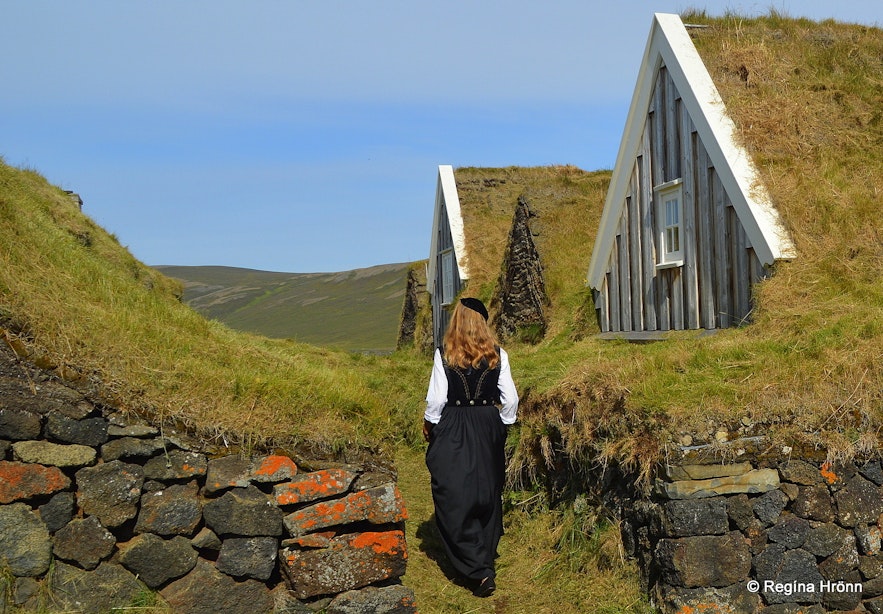
Þverá turf house in North-Iceland
Building a turf house was the traditional way here in Iceland. From the Settlement of Iceland, around 870, until the mid-20th century, Icelanders lived in turf houses, both rich and poor. The last inhabitants moved out of their turf-houses in the mid-20th century, around 1966.
Nowadays we don't have many turf houses left in Iceland as they need a lot of maintenance. But we still have a fair amount of them and several of the big turf houses now serve as a museum. Others cannot be visited as they are delicate and have to be preserved.
The thick turf walls and roof were designed to keep the cold out, making the turf houses well-insulated. Which was essential during the long cold winters of Iceland. At night, the inhabitants gathered in the baðstofa (sitting room), where they ate, did handiwork and slept. The inhabitants would often sleep two and two in a bed together, half sitting up.
The baðstofa at Skógar turf house
At the so-called kvöldvaka, one member of the household would read out loud for the others while they knitted, weaved and spun the wool. Everybody wore woollen clothes in the olden days to keep the cold out.
My grandmother is the only one of my grandparents who was born in a turf house, but she was born in 1923 in a very remote valley in the Westfjords of Iceland. I remember how excited we were about hearing her stories from the turf house when we were little. As back when I was born in 1965 the last inhabitants of the turf houses were moving out.
Most of Iceland's remaining turf houses belong to Þjóðminjasafn Íslands - the National Museum of Iceland and are a part of the National Museum's Historic Buildings Collection. If you see the sign below on a turf house then you know it belongs to the National Museum of Iceland.
The sign of Þjóðminjasafn Íslands - the National Museum of Iceland
I have written many travel-blogs about the few turf houses left in Iceland. In this travel-blog, I list them with a short description and a link to the travel-blog in question, where you will see many more photos and get much more information on each individual turf house, with directions on how to reach those turf houses, which are open to the public.
The "Original" Turf Houses in Iceland
Laufás turf house in North-Iceland 
Laufás turf house
Laufás turf house in Eyjafjörður in North Iceland is one of the bigger turf houses, which is now a museum. Laufás turf farm was built in 1866-1877 and here was a wealthy vicarage and a manor. 20-30 people were living in this turf house, which was first mentioned in the Book of Settlement.
The turf houses need a lot of maintenance and this beautiful turf house was rebuilt in 1957-1959, 1976-1978, 1994-2003 and 2009-2012 (source: Af jörðu - Hjörleifur Stefánsson - 2013).

Inside Laufás turf house
Laufás turf house has belonged to the National Museum of Iceland since 1948 but the nearby Akureyri Museum runs a museum in the summertime in the turf house.
See more in my travel-blog:
The Beautiful Laufás Turf House in Eyjafjörður in North-Iceland
Bustarfell turf house in East-Iceland
Bustarfell turf house in East-Iceland
Bustarfell turf house in East Iceland is one of the country's best-preserved turf houses and the only one of the big turf houses, which is painted in a beautiful red colour.
Bustarfell is a huge turf house and consists of 17 houses, but each gable and outhouse counts as one unit.
Bustarfell was inhabited from 1770-1966 when the last inhabitants moved out. By that time they had installed a wind generator for electricity. The same family has owned this land since 1532.
Inside Bustarfell turf house in East-Iceland
Bustarfell turf house, which has belonged to the National Museum of Iceland since 1943, is now a museum open to visitors in the summertime.
You can read more in my travel-blogs:
The beautiful Bustarfell Turf House in East-Iceland
The Sheriff's Wife at Burstarfell and the Elf-Rock in East-Iceland - Icelandic Folklore
Keldur turf house in South-Iceland
Keldur turf house in South-Iceland
The hall of the turf house at the historical Keldur in South Iceland is believed to be the oldest turf house hall remaining in Iceland. Which makes the turf house of Keldur the oldest house in Iceland - at least parts of it.
The front buildings at Keldur are parallel to the farmyard, which is an old turf house design, which has been used here at Keldur since the middle ages. At Keldur you will also find the oldest remaining structure in Iceland, an underpass that is believed to date back to the 11th-13th century or the Age of the Sturlung.
Turf houses don't last and have to be maintained all the time, and the present turf house at Keldur was rebuilt after earthquakes shook this area back in 1896 and 1912. And throughout the years this old turf farm has been rebuilt and refurbished, f.ex. in 1975-1977 and again in 1985, 1994 and 2000.
Inside Keldur turf house in South-Iceland
Keldur turf house came into the possession of the National Museum of Iceland back in 1942. The turf house is open as a museum in the summertime.
See much more information and photos in my travel-blog, including which great people lived at Keldur:
Keldur Turf House in South Iceland - is this the oldest House in Iceland?
Grænavatn turf house at Mývatn in North-Iceland
Grænavatn turf house in North-Iceland
In the Mývatn area by Lake Grænavatn, you will find a beautiful turf house called Grænavatn turf house or Green lake turf house.
Grænavatn turf house is 30 m long and 8 wide with a large front house, which was built in 1913. It was actually one of the largest front houses of its kind at that time here in Iceland. The building style is a later-time building style and the Grænavatn turf house is one of its kind in Iceland.
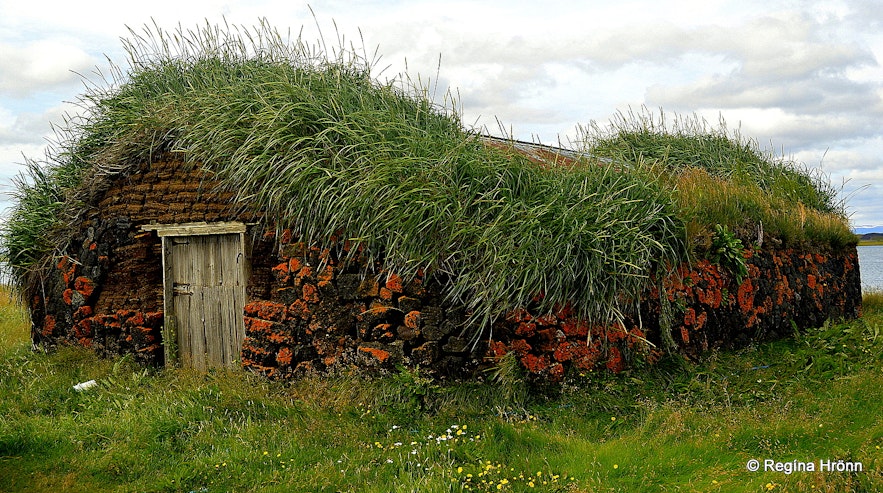
An old outhouse at Grænavatn turf house
The turf house was inhabited until 1952. Grænavatn turf house has belonged to the National Museum of Iceland since the year 2000.
Behind the turf house, you will find a distinctive-looking old turf barn, which might be around 160 years old.
You can read more and see a lot of photos in my travel-blog:
The Majestic Grænavatn Turf House at Mývatn in North-Iceland
Grenjaðarstaður turf house in North-Iceland
Grenjaðarstaður turf house in North-Iceland
Grenjaðarstaður turf house in North Iceland is a beautiful white turf house, which was the largest turf house in the county, some 775 sq.m.! The first mention of Grenjaðarstaður is from the early settlement of my country. It was a wealthy vicarage and a manor, built of turf, lava rocks from the vicinity and timber.
The oldest parts of the current turf houses date back to 1865. The turf house was restored completely back in 1876 by my great-great-grandfather, Benedikt Kristjánsson, who was the minister at that time at Grenjaðarstaður. My great-grandfather, Bjarni Benediktsson, was born in this turf house.
I was named after his mother, Regína Magdalena Sívertsen, who is buried in the graveyard at Grenjaðarstaður, and I regard this beautiful turf house as my family turf house ;)

Inside Grenjaðarstaður turf house in Iceland
Grenjaðarstaður turf house was inhabited until 1949. The stable has now been turned into a service centre for tourists.
Grenjaðarstaður has belonged to the National Museum of Iceland since 1954, and Menningarmiðstöð Þingeyinga - the Þingeyjasýsla County District Culture Centre has run a museum in the turf house in the summertime since 1958.
See much more in my travel-blog: Grenjaðarstaður Turf House in North Iceland and the Story of my Ancestors
Glaumbær turf house in Skagafjörður in North-Iceland
Glaumbær turf house in North-Iceland
Glaumbær turf house in Skagafjörður in North Iceland is one of the big turf houses, a manor where chieftains resided. Glaumbær has been inhabited since the settlement of Iceland, but some of the current turf houses were built in 1876-1879, with the oldest parts dating back to the mid-18th century.
Glaumbær consists of 14 houses. The last inhabitants moved out in 1947 and Glaumbær has since belonged to the National Museum of Iceland. Byggðasafn Skagfirðinga runs a museum in the turf house most months of the year (check their website for opening hours).
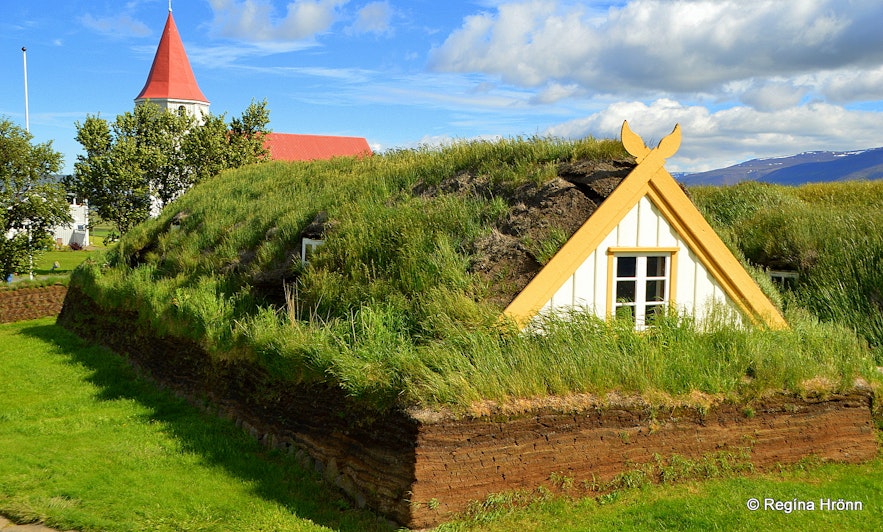
Glaumbær turf house in North-Iceland
You can read about the history of Glaumbær and see more photos in my travel-blog:
The historical Glaumbær Turf House in North-Iceland
Þverá turf house in Laxárdalur valley in North-Iceland
Þverá turf house in North-Iceland
The majestic Þverá turf houses - all 9 of them - were built in 1849-1851. The last inhabitants moved out of the turf house in 1964. One of the former inhabitants of the turf house, Áskell, lives next to the turf farm. Áskell has passed away now.
The turf houses in this area are mainly built from lava, seeing that this is a volcanic area. The roofs are insulated with dwarf birch and turf.
When I visited Þverá I noticed that a creek had been channelled through one of the rooms - what a clever idea.
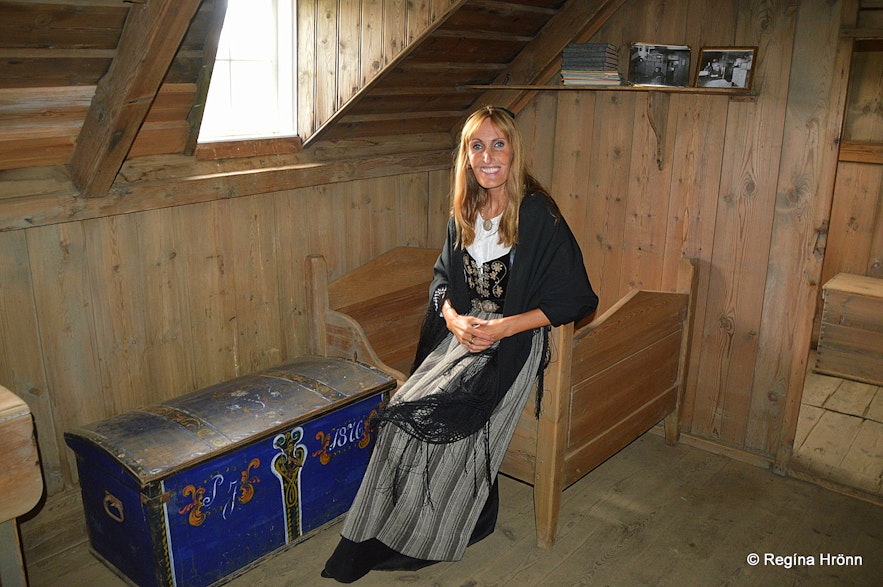
Inside Þverá turf house
Þverá turf house has belonged to the National Museum of Iceland since 1968 and it was preserved in 1990. It is off the beaten path and is currently under repair so it is closed to visitors.
My husband's paternal grandmother lived at Þverá turf house with her family, and Áskell is my husband's relative, so we visit Þverá every year when we travel to this area, and he has shown us around the turf house.
Þverá turf house in North Iceland and Þverárkirkja church
Read more in my travel-blog about Þverá turf house where you can find many photos of this beautiful turf house.
Þverá turf house is one of my favourite photo models:
The majestic Þverá Turf House in North Iceland - closed to Visitors while it is under repair
Nýibær turf house at Hólar in Hjaltadalur in North-Iceland
Nýibær turf house in North-Iceland
The turf house at the historical Hólar in Hjaltadalur is called Nýibær - New Farm and was built in 1860. The name, New Farm, is unusual, but it was called this name as the old turf farm was still on the site when Nýbær was being built.
Nýibær turf house was inhabited until 1945. Nýibær has belonged to the National Museum of Iceland since 1956, which reconstructed it and opened it to the public in 1958. Turf houses have to be maintained frequently and in 1997-2000 Nýibær got a makeover.
Nýibær turf house in North-Iceland
The beautiful turf house itself is the showpiece and it is not furnished, like the other turf houses, which are now museums. You can visit it between 8:00-18:00 and there is no admission fee:
See my travel-blog for much more information and road directions:
The historical Hólar in Hjaltadalur, the Episcopal See and Nýibær Turf House
Árbær turf house in Reykjavík in South-West Iceland
Árbæjarsafn turf house in SW-Iceland
At Árbæjarsafn Folk Museum in Reykjavík, you will find Árbær turf house, the only turf house left in Reykjavík, the capital city of Iceland. Árbær turf house was built around 1890-1918 and was reconstructed in 1968.
The first written record of a turf farm at Árbær dates back to 1464. Archaeological excavations have shown that there might have been a farmstead here as early as 1226, as ruins of walls of outhouses have been found.
At Árbæjarsafn Folk Museum you will find a beautiful turf church, but you can see parts of it in my photo above. On the other side of the road, you will see another beautiful turf house; the vestry. I will show you both of these turf structures later in this travel-blog.
Inside Árbæjarsafn turf house in SW-Iceland
Árbær turf house was inhabited until 1948 and became a museum in 1957. I highly recommend visiting this museum while in Reykjavík! If only for meeting these two inhabitants ;)
I have written a special travel-blog about my Christmas visit to the folk museum, where you can see many winter photos of the turf house and the turf church, but turf houses are ever so beautiful in the snow:
Christmas visit to Árbær Folk Museum
Stóru-Akrar turf house in Skagafjörður in North-Iceland
Stóru-Akrar turf house in North-Iceland
Stóru-Akrar turf house in Skagafjörður in North Iceland is a reconstructed turf house of an older turf house, which was built in the 18th century by Skúli Magnússon, the Treasurer of Iceland. Skúli was the Sheriff here in Skagafjörður from 1711-1794.
Skúli's turf house was built from 1743-1745 and rebuilt in 1955 and again in 1989-1990. Stóru-Akrar turf house has been in the care of the National Museum of Iceland since 1954. It is being rebuilt and is not open to visitors.
Stóru-Akrar turf house in North-Iceland
At Akrar lives Helgi Sigurðsson, the head of Fornverkaskólinn, who teaches the old ways of building a turf house at Tyrfingsstaðir turf farm, which you can read about a little further in this travel-blog. He has rebuilt the old farm at Stóru-Akrar and done a beautiful job. I have been following the reconstruction for some years now and my last photo of Stóru-Akrar turf house was taken in the summer of 2017.
Íslenski bærinn turf house at Austur-Meðalholt in South-Iceland
Íslenski bærinn turf house at Austur-Meðalholt in South-Iceland - an outhouse
At Austur-Meðalholt in South Iceland, you will find a turf house that dates back to 1895. A turf farm has been in this location for at least 400 years and the last inhabitants moved out of the current turf house in 1965. My photo above is of a turf shed next to the turf house. It is so cute and one of my photos on Pinterest which gets saved most often.
This turf house is privately owned and a museum. The owner, Hannes, who was born in this turf house, will show you around the turf house and the excellent photo exhibition of old turf houses. At the exhibition, you will see photos of lost turf houses, and if you are anything like I, then be prepared to spend an hour at the photo exhibition ;)
Inside Íslenski bærinn turf house at Austur-Meðalholt in South-Iceland
The turf house at Austur-Meðalholt, or Íslenski bærinn, as it is also called, meaning the Icelandic turf farm, is built in the sunnlenskur style (the southern style) and made with turf and rocks and timber. Corrugated iron has been added to the walls and roof to protect them from the Icelandic climate. All in all, there are 8 turf houses at Austur-Meðalholt, including a barn and stables.
Read more in my travel-blog, where you can see a lot more photos and road directions:
Íslenski bærinn turf farm at Austur-Meðalholt in South-Iceland
Arngrímsstofa turf house in Svarfaðardalur in North-Iceland
Arngrímsstofa turf house in Svarfaðardalur in North-Iceland
At Tjörn in Svarfaðardalur valley in North Iceland, you will find a small turf house, which has belonged to the National Museum of Iceland since 1953.
The small farm is called Gullbringa and the small turf house from 1884 is called Arngrímsstofa.
In it lived and worked the noted Arngrímur Gíslason, folk artist (1829-1887), who built the turf house himself of turf, rock and timber. The turf house is only 2.4 x 2.5 metres and is the oldest atelier in Iceland.
Inside Arngrímsstofa turf house in Svarfaðardalur in North-Iceland
Arngrímsstofa was rebuilt in 1983 in memory of our former President Kristján Eldjárn, who was born at Tjörn in Svarfaðardalur.
The turf house is in the possession of the National Museum of Iceland and is open daily from 8:00-18:00.
Selið turf house in Skaftafell in South-Iceland
Selið turf house in Skaftafell in South-Iceland
Selið turf house is located in Skaftafell in South Iceland. It was built in the southern style in 1912 and inhabited until 1946. There are very few remaining turf houses in South Iceland, so this turf house is well worth a visit while hiking in Skaftafell.
An older turf house was moved up on the hill to the current location of Selið back in 1832-1850 when the glacial river Skeiðará was acting up. The building material of Selið turf house is driftwood, turf and rock.
Inside Selið turf house in Skaftafell in South-Iceland
Selið turf house has been in the possession of the National Museum of Iceland since 1972 and was rebuilt in 1970-1980. It is open to visitors from 8:00-18:00.
I have written a travel-blog about the beautiful Skaftafell with a section about Selið turf house:
Svartifoss & other astonishing Attractions in Skaftafell in South-Iceland
Reynistaður turf house in Skagafjörður in North-Iceland
Reynistaður turf house in Skagafjörður in North-Iceland
A lone gable at Reynistaður in Skagafjörður (Staðarhreppur) represents an old turf farm, which has belonged to the National Museum of Iceland since 1999. When the turf farm was torn down shortly after 1935 this gable was left to show the stave constructions from the 18th century. The turf gable has been moved and reconstructed.
Reynistaður was a manor and here many a chieftain lived, f.ex. Þorfinnur karlsefni and his wife Guðríður Þorbjarnardóttir, who lived here in the 11th century after returning from America. In the 13th century, Reynistaður was one of the manors of the powerful Viking Clan of Ásbirningar. And one of the casualties of the Haugsnesbardagi battle in 1246, Brandur Kolbeinsson, lived here.
Inside Reynistaður turf house in Skagafjörður in North-Iceland
Gissur Þorvaldsson of the Viking Clan of Haukdælir - who was for a while the Earl of Iceland lived for some time at Reynistaður. Before his death, Gissur donated Reynistaður to a nunnery and from 1295-1552 a cloister was located here. So you can see that this was quite a historical place.
I have not written a separate travel-blog on Reynistaður, so I went into some detail here. In the photo above you can see how the turf walls are panelled with wood. The turf house is open daily from 8:00-18:00 - please tread carefully.
Skógar turf houses in South-Iceland
Skógar turf houses in South-Iceland
At Skógar Museum you will see a beautiful turf house, which is not original per se in this location, but a reconstruction of original turf houses from different locations from this area in South Iceland. The first turf house at the museum was moved to this location back in 1968, but around that time the last inhabitants of the turf houses moved out.
Additional six turf houses were moved to Skógar Museum from different locations in the vicinity. I think this is an excellent idea and am glad that these turf houses were preserved in this way.
Inside Skógar turf houses in South-Iceland
Here you will find a storehouse dating back to 1830, a bedroom from 1838, a pantry from 1850, a cruciform cowshed from 1880 and a kitchen from that same year, a baðstofa from 1895 - which was the main room, where people would eat, work, and sleep, and a sitting room from 1896. All are fully furnished, showing us how people lived back in the olden days in Iceland.
See also my travel-blog:
Skógar Museum - An Excellent Regional Museum & Turf House in South-Iceland
Galtastaðir-fram turf house in East-Iceland
Galtastaðir-fram turf house in East-Iceland
Galtastaðir-fram in East Iceland is a small turf farm, which has belonged to the National Museum of Iceland since 1976. It is one of the turf houses, which is closed to the public.
Galtastaðir-fram was built in the 19th century - a modest turf farm inhabited by poorer people, as opposed to the big manors I have shown you earlier. It was inhabited until 1967 and a new concrete farm was built next to it in 1960.
The barn was underneath the baðstofa where people worked, ate and slept, but this arrangement gave the inhabitants of the turf house warmth from the cows.
Galtastaðir-fram turf house in East-Iceland
The building type of Galtastaðir-fram is neither southern nor northern, but Galtastaðagerð type, which is an older type of turf house.
I include it here in my list even though it is closed to the public, as I am showing you different turf houses in Iceland, not only the ones, which are open to the public.
Here is my travel-blog: Galtastaðir-fram and other traditional Turfhouses in East Iceland.
Tyrfingsstaðir turf house in North-Iceland
Tyrfingsstaðir turf house in North-Iceland
Off the beaten path in Skagafjörður at Kjálki, you will find a privately owned turf house, Tyrfingsstaðir turf house.
Tyrfingsstaðir turf house dates back to 1870-1895, with a timber house facade from 1904, very characteristic.
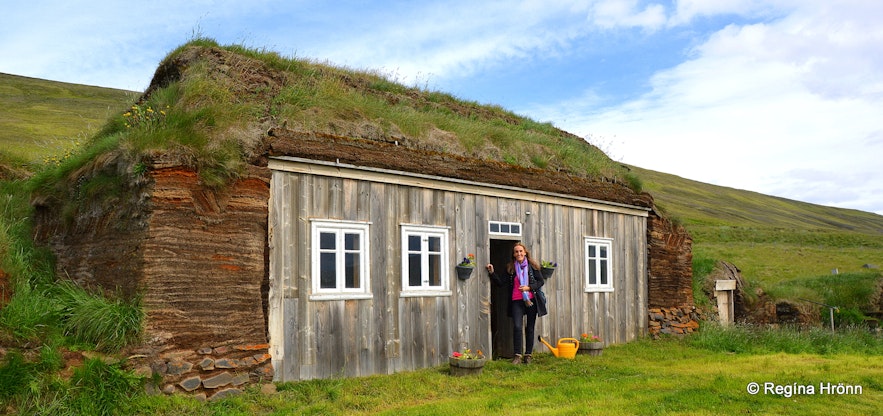 Tyrfingsstaðir in the summer of 2022
Tyrfingsstaðir in the summer of 2022
Tyrfingsstaðir turf house is built in the Marbæli style and is a good example of what the common turf farms looked like in the first part of the 20th century.
Tyrfingsstaðir turf house was inhabited until 1969.
At Tyrfingsstaðir you will find 5 turf houses and 4 turf outhouses, which are being restored by the Skagafjörður Heritage Museum and Fornverkaskólinn.
Tyrfingsstaðir turf house in North-Iceland
Thus the old method of building turf houses is being passed on to the new generations of Icelanders. I would love to join one of their courses.
See also my travel-blog:
Tyrfingsstaðir turf house in North Iceland with many more photos of this special turf farm
Núpsstaður turf house in South-Iceland
Núpsstaður turf outhouses in South-Iceland
At Núpsstaður in South Iceland, a dilapidated turf house can be found, dating back to the 18th and 19th centuries. The turf house is on private ground, so there is no access to it anymore and neither can the turf church at Núpsstaður be visited anymore.
My photos are from my visit a couple of years back.
Núpsstaður turf farm consisted of 15 turf houses, but 4 are in ruins. The photos I post here are of the turf outhouses at Núpsstaður. These turf houses were made of turf, rocks and driftwood.
Núpsstaður turf outhouse in South-Iceland
You can see the turf church in my section on turf churches in Iceland, a little bit later in this travel-blog.
Lindarbakki turf house in East-Iceland
Lindarbakki turf house in East-Iceland
In Borgarfjörður-Eystri in East-Iceland, you will notice a small brightly red-painted turf house, Lindarbakki turf house. The oldest part of Lindarbakki dates back to 1899, but the woodwork dates mainly back to 1934. The cellar in the turf house and the well are original.
Lindarbakki is inhabited in the summertime and is only one of the very few turf houses, in which people still live.
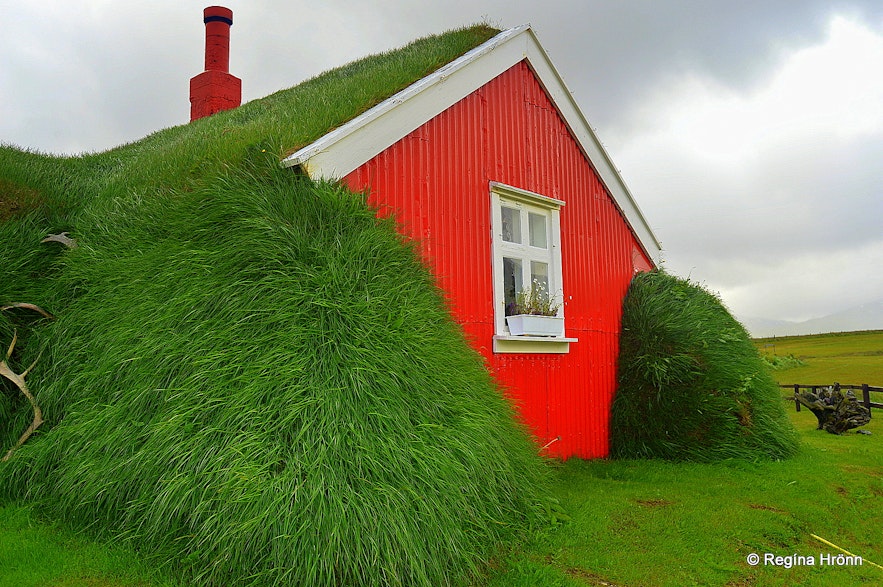
Lindarbakki turf house in East-Iceland
I have written a special travel-blog where you can see more photos of this cute little red-painted turf house:
Lindarbakki Turf House in Borgarfjörður-Eystri in East-Iceland
Barmar turf house in Reykhólasveit
Barmar turf house in Reykhólasveit
Barmar turf house is a privately owned turf house in the Westfjords. It is located very close to Reykhólar, about which I have written a travel-blog in I-III parts.
Barmar had become dilapidated in 1925, but the owner and his neighbours restored it to its original form. The turf house was abandoned in 1967 around the time the last inhabitants of turf houses in Iceland moved out. With the help of professionals, a new owner put a lot of time, money and work into restoring Barmar to its original form.
Barmar is one of the few turf houses which is privately owned. Thus it is not possible to visit it. But you can have a peek at it from the road above.
I have by now shown you most of the old turf houses in Iceland, owned by the National Museum of Iceland or privately owned. There are also a couple of abandoned turf houses.
Brattahlíð & Bergsstaðir in Svartárdalur valley in North-Iceland
Brattahlíð in Svartárdalur valley North-Iceland
In Svartárdalur valley in North Iceland, you will find two abandoned turf farms made of driftwood with a turf roof. The first one is called Brattahlíð and the second one is called Bergsstaðir.
Unfortunately, since my visit, Brattahlíð has been torn down and Bergsstaðir collapsed :(
Brattahlíð was built in 1904-1905 and inhabited until 1978.
The less travelled valleys in Iceland often have hidden treasures and visiting these farms, especially the one at Bergsstaðir, made me feel like I stepped back into Iceland in olden times. So it was well worth the visit.
Bergsstaðir in Svartárdalur valley North-Iceland
By Bergsstaðir abandoned farm stands a lovely little farm church, one of many in Iceland, called Bergstaðakirkja church, dating back to 1883. I visit all the churches in Iceland on my travels around my country, but the little farm churches dotted around Iceland are another passion of mine :)
Turf churches in Iceland
Now I am going to show you the turf churches in Iceland. There are only 5 original turf churches left in Iceland plus 1 reconstructed turf church and a couple of hypothesis turf churches.
Grafarkirkja turf church - the oldest one of them all
Grafarkirkja turf church in North-Iceland
Grafarkirkja turf church in North Iceland - is the oldest of Iceland's turf churches and is closed to the public for its preservation. Parts of it date back to the 17th century. The oldest mention of a church in this place is from 1240 and can be found in Sturlunga Saga.
Grafarkirkja church is made from timber and turf. It is believed to have been built by Guðmundur Guðmundsson from Bjarnastaðahlíð, a well-known carpenter in the 17th century. This beautiful turf church was repaired in 1950 and again in 2011.
Grafarkirkja belongs to the National Museum of Iceland and is a part of their Historic Buildings Collection.
Grafarkirkja turf church in North-Iceland
You will notice lovely baroque-style carvings on the wooden roof trims of Grafarkirkja. I have not seen such carvings in other churches in Iceland.
See also my travel-blog Grafarkirkja Turf Church in North Iceland - the oldest Turf Church in Iceland.
Grafarkirkja turf church is now closed to the public for its preservation, but you can have a look at it from the outside.
Núpsstaðakirkja turf church - the smallest one
Núpsstaðakirkja turf church in South-Iceland
I told you about the turf house at Núpsstaður earlier in this travel-blog. Now I am going to show you the beautiful little turf church at Núpsstaður. This tiny church, which is the smallest of the turf churches left in Iceland, was built before 1657, so the oldest parts of it are from the 17th century.
In 1765 it was deconsecrated and used as an oratory - later as a storehouse. Since 1930 it has been under the care of the National Museum of Iceland, and is the first house to receive the honour of being declared as protected by the Director of the National Museum. In 1958-1960 it was repaired and reconsecrated.
The little altar inside the turf church dates back to 1789. I took this photo when the church was still open.
This turf church is now closed to the public. My photos of the church were taken some years back when it was still open.
I have written more in another travel-blog: Núpsstaður Turf Church and Mt. Lómagnúpur in South Iceland - the smallest Turf Church
Hofskirkja turf church - the newest one
Hofskirkja turf church in South-Iceland
Hofskirkja turf church in Öræfi in SE-Iceland is the last one of the remaining turf churches to be built in this beautiful turf style.
Hofskirkja was built in 1883-1885, but a church has been on this site for much longer or around 700 years. The first mention of a church at Öræfi was in an old medieval document from 1343. Hofskirkja turf church was rebuilt in 1953-1954.
Inside Hofskirkja turf church in South-Iceland
This "newest" original turf church is made out of rocks (the walls) and stone slabs with turf (the roof). On the website of the National Museum of Iceland, it is written that this turf church is now closed to the public.
You can read more about Hofskirkja turf church in my travel-blog Hofskirkja Turf Church in Öræfi in South-East Iceland - the youngest one
Saurbæjarkirkja turf church - the biggest one
Saurbæjarkirkja turf church in North-Iceland
The biggest turf church in Iceland, Saurbæjarkirkja, can be found in the innermost part of Eyjafjörður fjord in North Iceland. This beautiful turf church was erected in 1858 and seats 60 people.
Saurbæjarkirkja is made of thick turf, rock and wood. It looks massive compared to the other turf churches. In 1960 a concrete cellar was added to the church and it was reconstructed in 2002-2005. It is so beautiful on the inside with lots of colours.
Inside Saurbæjarkirkja turf church in North-Iceland
Saurbæjarkirkja has belonged to the National Museum of Iceland since 1962.
See also:
Saurbæjarkirkja Turf Church in North Iceland - the biggest Turf Church in Iceland
Víðimýrarkirkja turf church - the most beautiful one
Víðimýrarkirkja turf church in North-Iceland
Víðimýrarkirkja turf church is to be found in Skagafjörður in North Iceland. Iceland's third president, Kristján Eldjárn, who was the Director of the National Museum of Iceland prior to becoming our president, described this church as being the most clear-cut and beautiful relics of old Icelandic architecture there is.
Another Director of the National Museum of Iceland, Matthías Þórðarson, saved this little gem from being torn down and replaced by a concrete church. Imagine that, we could have lost this little turf church! It has belonged to the National Museum of Iceland since 1936.
Víðimýrarkirkja turf church in North-Iceland
Víðimýrarkirkja turf church was built in 1834. It is built of turf from Víðimýri and driftwood from the nearby Skagi. The lychgate is from 1936, but the bells date back to 1630. The church has been refurbished and repaired over the years. It is open as a museum in the summertime.
You can read more about this beautiful little gem in my travel-blog Víðimýrarkirkja Turf Church in North Iceland - is it the most beautiful of them all?
Árbæjarkirkja turf church - the rebuilt one
Árbæjarkirkja turf church in SW-Iceland
At Árbæjarsafn Folk Museum in Reykjavík, you will find a lovely turf church. It is special in way that it is a rebuild of an older church, which was built in 1842. That church was located at Silfrastaðir in Skagafjörður in North Iceland - and torn down 54 years later, in 1896.
Timber was valuable in Iceland, seeing that we have few trees here, so timber was reused. Parts of the timber from the old church were used for baðstofa - the sitting room - on the farm by the old church. Later on, in 1959, that baðstofa was torn down and the timber was again reused, this time for building this beautiful turf church at Árbæjarsafn Museum.
Isn't it beautiful? It is the only turf church we have got in Reykjavík - and it isn't even of Reykjavík origin.
Inside Árbæjarkirkja turf church in SW-Iceland
The turf church was built to the liking of the old church at Silfrastaðir and consecrated in 1961 at Árbæjarsafn Folk Museum. The altar and the pulpit in the church are original.
Árbæjarkirkja church is the sister church of Víðimýrarkirkja turf church in Skagafjörður, the one I told you about here above.
In my photo below you will see the vestry which is opposite Árbæjarkirkja turf church. I have noticed that some people take this to be the turf church and I can understand why as it is also a pretty turf house, but the turf church is bigger.
The vestry opposite Árbæjarkirkja turf church in SW-Iceland
The vestry was built in 1964 in the liking of a vestry in Ölfus and is used when services take place in the turf church.
I want to show you the first photo of me by the turf church at Árbæjarsafn Folk Museum. It was taken by my grandfather, Pétur Thomsen, who was a professional photographer.
We donated his collection of photos and films to Ljósmyndasafn Reykjavíkur - the Reykjavík Museum of Photography and somehow this photo from our private collection got mixed in with the other photos, so it has got the logo of the museum.
I am the one in the front with the pacifier ;) with my sister and my mother in 1966.
Check out my travel-blog Árbæjarsafn Open Air Museum in Reykjavík for winter photos of the turf houses.
Geirsstaðakirkja turf church - a replica of an old turf church
Geirsstaðakirkja turf church in East-Iceland
In East-Iceland you will find a replica of a 1000-year-old farm turf church, Geirsstaðakirkja church.
A similar, or so we believe, turf church stood on this spot during Viking time, some 1000 years ago.
The turf church was discovered in an archaeological dig back in 1997 on the land of Geirsstaðir, together with a Viking longhouse and a circular wall surrounding the buildings.
Inside Geirsstaðakirkja turf church in East-Iceland
The replica of Geirsstaðakirkja was built in 1999-2001 close to the ruins of the Viking longhouse and the old turf church. It was built in the traditional way, using only turf, wood and rock.
Read more in my travel-blog:
Geirsstaðakirkja Turf Church in East Iceland - a Replica of an old Turf Church
Bænhús á Efri-Brú - a hypothetical turf church 
Bænhús á Efri-Brú in South-Iceland
A hypothetical turf church has been erected at the farm Efri-Brú in South Iceland.
According to old sources, the chapel at Efri-Brú had collapsed in 1708 and only the outwalls were standing.
The chapel at Efri-Brú was built to the liking of the style of chapels in Iceland from around 1200-1550 until the Reformation.
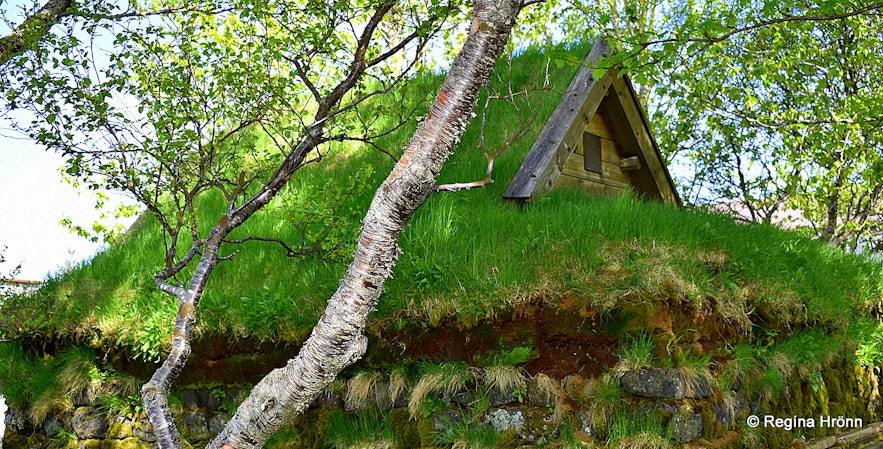
Bænhús á Efri-Brú in South-Iceland
I stayed at the hotel at Efri-Brú for one night and can recommend this beautiful location. Unfortunately, the hotel went bankrupt due to Covid-19.
Hypothetical turf houses
We have got 4 hypothetical turf houses in Iceland, which were erected close to Viking ruins discovered during archaeological excavations. Some of them are built with modern-day materials.
Þjóðveldisbærinn - the Saga Age farm
Þjóðveldisbærinn - the Saga Age farm
In Þjórsárdalur valley upcountry in South Iceland, you will find a hypothetical Viking longhouse, called the long name Þjóðveldisbærinn - the Commonwealth Farm.
This longhouse was built to the liking of the Viking ruins at Stöng, which are in the vicinity, but much less accessible.
Inside Þjóðveldisbærinn - the Saga Age farm you can dress up in Viking clothes
Archaeologists found the ruins of Stöng back in 1939 under layers of tephra from the volcano Hekla. The ruins had been hidden under the tephra for 835 years when they were unearthed.
The hypothetical longhouse was built from 1974-1977 on the 1100th anniversary of the Settlement of Iceland.
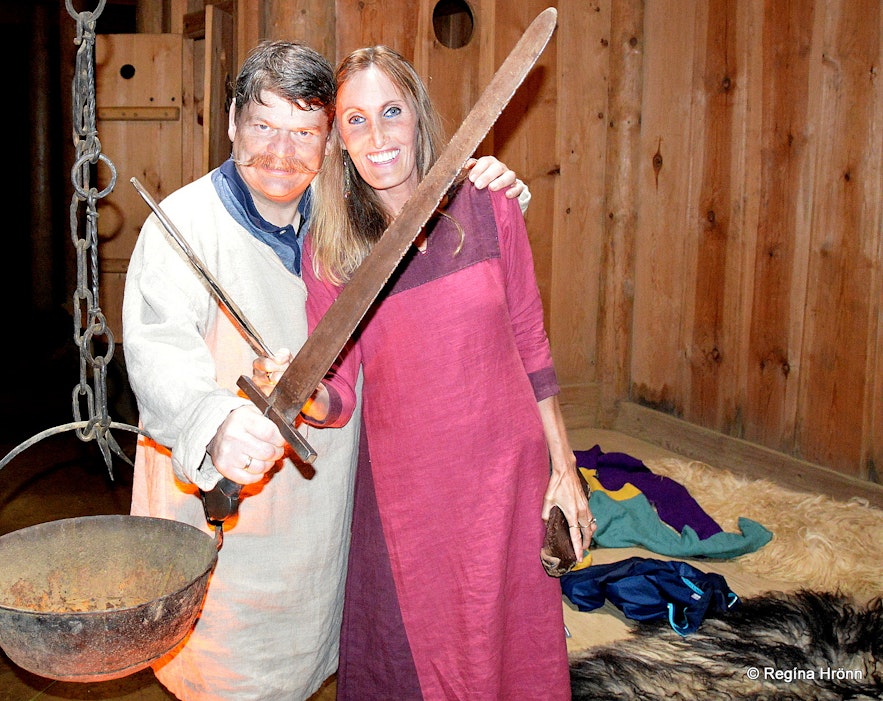 With my husband at Þjóðveldisbærinn ;)
With my husband at Þjóðveldisbærinn ;)
It has got stone walls, as it is really hard to maintain the turf houses, which are built in the traditional way. The hypothetical stave church was built in the year 2000. Þjóðveldisbærinn is open as a museum in the summertime.
You can read more and see photos of the inside of the original Viking longhouse in my travel-blog:
Stöng - Ruins of a Real Viking Settlement Manor and the Reconstructed Saga-Age Farm in Iceland
Skálholt and Þorláksbúð
Skálholt and Þorláksbúð in South-Iceland
Þorláksbúð is a hypothesis turf house at the historical episcopal See Skálholt in South Iceland.
The hypothesis turf house stands next to the modern-looking Cathedral of Skálholt.
I quite like this little turf-house, built of wood and turf and to me it stands there as a reminder of earlier building styles.
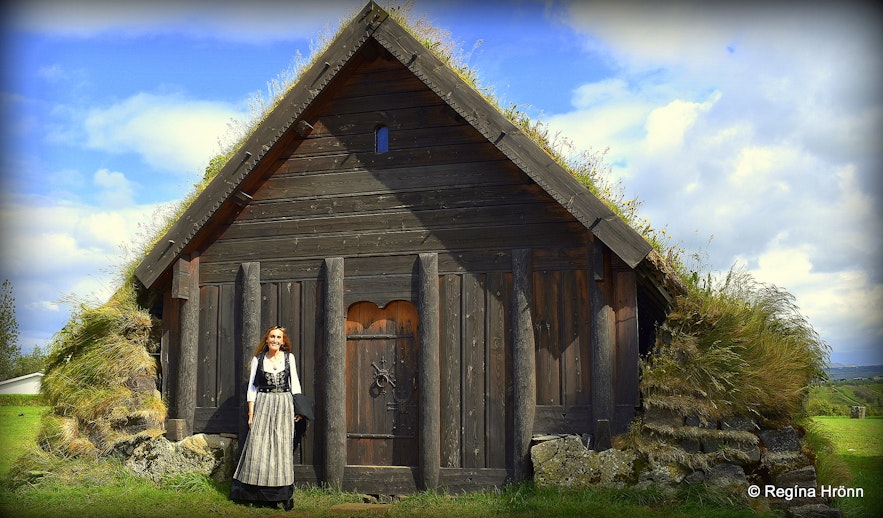 By Þorláksbúð during the Skálholtshátið festival
By Þorláksbúð during the Skálholtshátið festival
The hypothesis house was built in 2011-2012 by the ruins of the temporary chapel called Þorláksbúð, but the ruins were found back in 1954.
The old Þorláksbúð was built in 1527 after the timber church Árnakirkja burnt down and was in use from around 1530-1784.

Skálholt and Þorláksbúð in South-Iceland
See also my travel-blog:
The historical Skálholt Episcopal See in South-Iceland
Herjólfsbærinn - Herjólfur's old farmstead in the Westman Islands
Herjólfsbærinn - Herjólfur's old farmstead
In Herjólfsdalur valley in the Westman islands, you will find the hypothesis house Herjólfsbærinn - Herjólfur's old farmstead.
Three ruins of a very old Viking turf longhouse and smaller houses were discovered here back in 1924.
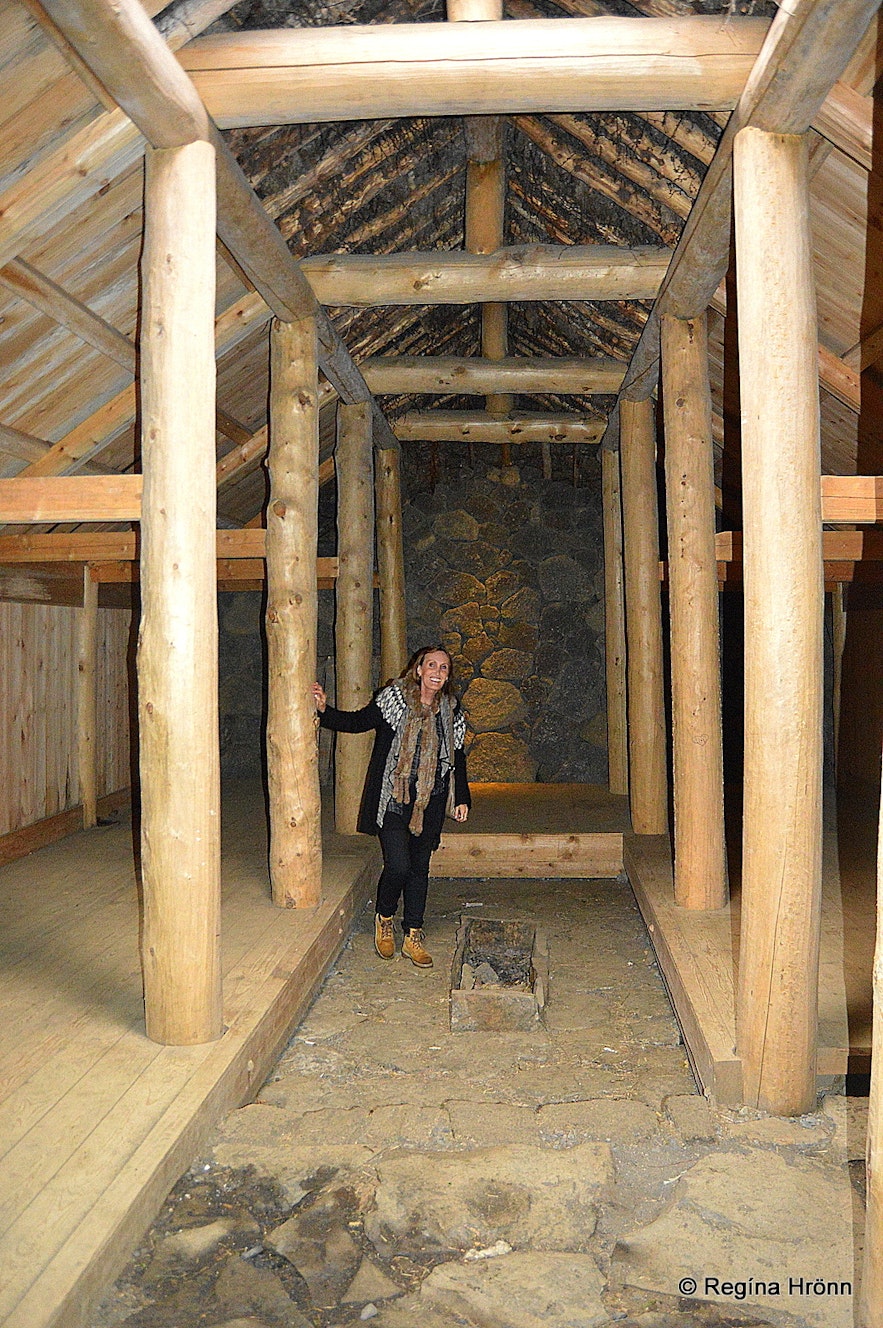 Inside Herjólfsbærinn turf farm - a museum is opening up in 2023
Inside Herjólfsbærinn turf farm - a museum is opening up in 2023
Archaeological excavations in 1971-1983 unearthed 8 turf houses from 4-5 periods.
Did they discover the longhouse of the first settler of the Westman Islands and Herjólfur Bárðarson (around 900)?
The hypothesis house shows us what we believe the oldest type of turf houses in Iceland looked like in the 9th-10th century. It was erected in 2006 and is made with rocks, wood and turf.
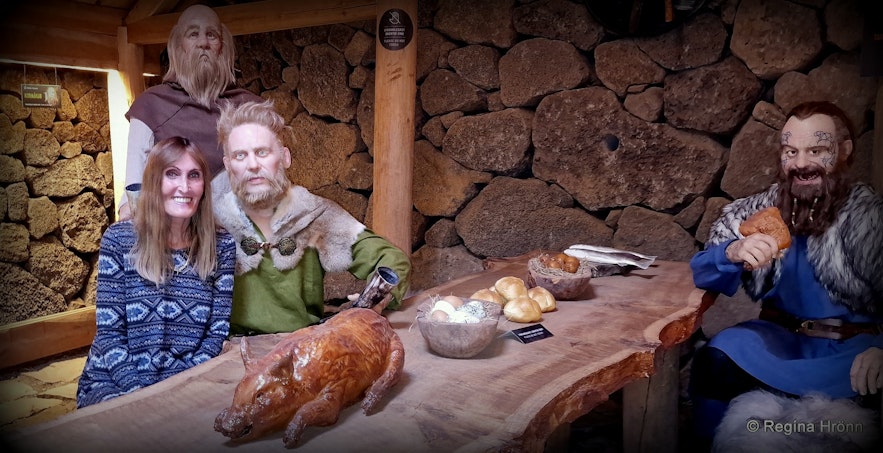
Inside Herjólfsbærinn - Herjólfur's old farmstead
A Viking exhibition was opened in Herjólfsbærinn in the spring of 2023.
See also my travel-blog:
Herjólfsbærinn - Herjólfur's Old Farmstead in the Westman Islands
Eiríksstaðir - the turf house of Erik the Red & Leif the Lucky
Eiríksstaðir - the turf house of Erik the Red in West Iceland
Another hypothetical turf farm has been erected at Eiríksstaðir, the turf farm of Erik the Red and Leif the Lucky.
Here you can experience how people lived some 1000 years ago during the time of the Settlement of Iceland.
Guides dressed up as Vikings will tell you about the life of the Vikings, who lived at Eiríksstaðir turf farm. You can sit by the longfire, dress up in a Viking costume and handle Viking weapons.
Inside Eiríksstaðir - the turf house of Erik the Red in West Iceland
Close to the hypothetical turf farm, you can visit the excavated ruins of the real farm. This is a truly memorable visit.
See also my travel-blog:
Viking Areas in Iceland - Eiríksstaðir Long House in West Iceland
Latter time & rebuilt turf houses
We have several later-time & rebuilt turf houses in Iceland, which are either built in the traditional way or only made to look like turf houses but built with modern-day building materials.
Hofsstaðir turf house in Skagafjörður
Hofsstaðir turf house in Skagafjörður North-Iceland
Hofsstaðir in Skagafjörður was erected in 1906 and totally rebuilt in 1997-2001. The owner told me that there had been only a very small part of the turf house left, so it was completely rebuilt.
I popped in for a quick look around and it is both cosy and modern looking. The owners run a restaurant and a guesthouse on the opposite side of the road in Skagafjörður.
Sænautasel turf house in East Iceland
Sænautasel turf house in East Iceland
Sænautasel turf house, on Jökuldalsheiði heath in the highland of Iceland, is a lovely-looking turf house.
It is a turf house in which the common people lived and doesn't belong to the National Museum of Iceland. It has been rebuilt from scratch from an older farm.
Inside Sænautasel turf house in East Iceland
The proprietors live in the turf house in the summertime and run a café in the old turf sheepcote. My photo above is not of the café ;) but the old kitchen inside the old turf house.
Sænautasel turf house was built in 1843 and was inhabited until 1943. There used to be 16 other turf houses on the heath, which got abandoned during the volcanic eruption in 1875 in Askja, including Sænautasel.

The turf farm was rebuilt in 1880. Sænautasel was again rebuilt in 1992 and is now a museum and a café.
You can see a lot more photos in my travel-blog:
Sænautasel Turf House in the Highlands of Iceland
Litlibær turf house in the Westfjords of Iceland
Litlibær turf house in the Westfjords of Iceland
At Hvítanes peninsula in Skötufjörður fjord in the Westfjords of Iceland, you will find a lovely little reconstructed turf house called Litlibær, or the Small farm. In this turf house, you will find a café.
This cute little turf house is a reconstruction of a turf house that was erected around 1895. Two couples had been assigned this land and they erected Litlibær turf house together. They divided the turf house into two parts for each of their families.
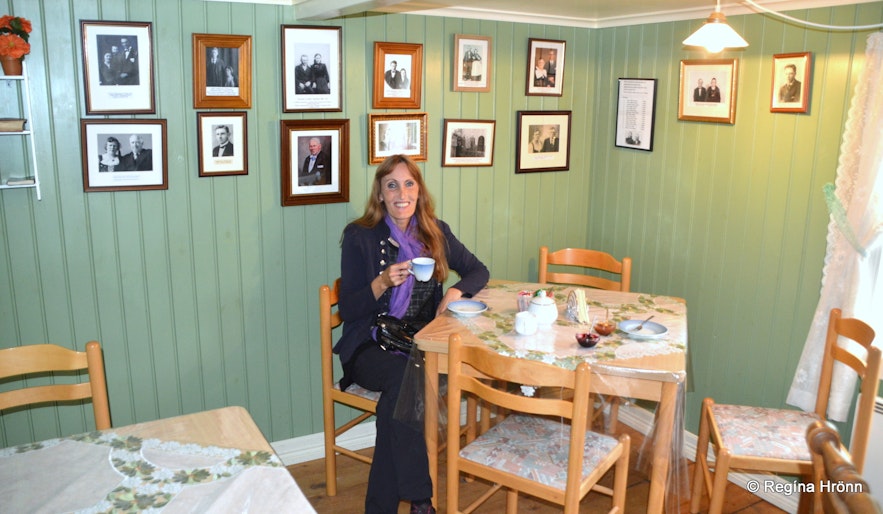
Litlibær turf house in the Westfjords of Iceland - enjoying a cup of coffee at their cute café
Litlibær turf house was inhabited until 1969, which is the decade when the last inhabitants were moving out of the traditional turf houses and Litlibær stood abandoned.
In 1999 - 30 years after Litlibær was abandoned - Þjóðminjasafnið - the National Museum of Iceland - rebuilt it in its original turf house form and now Litlibær serves as a good example of the turf houses in which the less affluent lived. I applaud that our National Museum took on this project.
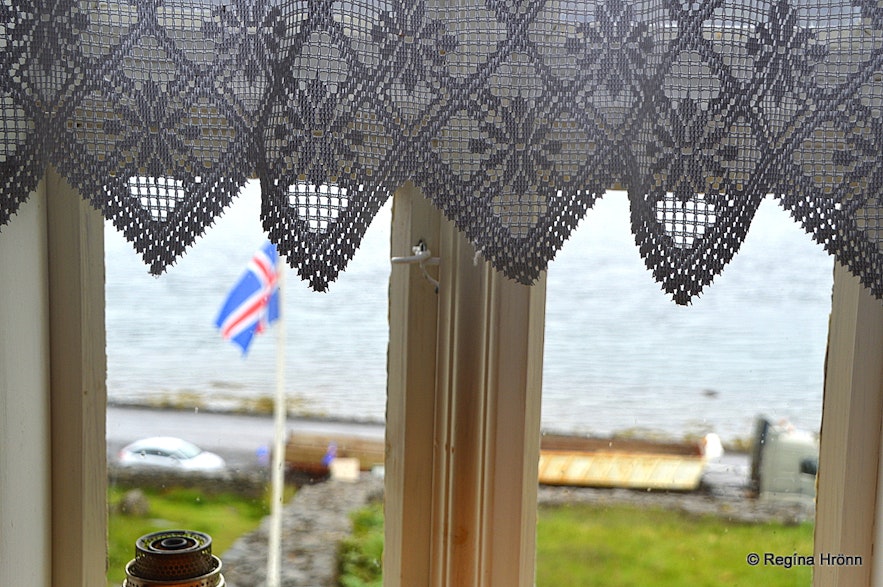
Litlibær turf house in the Westfjords of Iceland
Byggðasafn Vestfjarða - the District Museum of the Westfjords is in charge of the museum which shows us the ways of living of farmers and fishermen in this area in the first part of the 20th century. The entrance to the museum is free of charge.
Litlibær is open during the summertime from mid-May until the beginning of September. Check them out on Facebook.
I have written a special travel-blog about Litlibær turf house if you want to see more photos of this lovely little turf house:
Litlibær in the Westfjords of Iceland - a Cute little Turf House Café and Museum
Hrafnseyri turf house in the Westfjords of Iceland
Hrafnseyri turf house in the Westfjords
At Hrafnseyri in the Westfjords of Iceland, you will see a beautiful reconstructed turf house. Hrafnseyri is the birthplace of our national hero Jón Sigurðsson, and the turf house is a hypothetical replica of the turf farm in which Jón was born.
In the turf house, which was built in 1997, you will find a café. Also, visit the interesting museum on Jón Sigurðsson, which is located next to the turf house.
Check them out at Hrafnseyri.
The Sorcerer's Cottage in the Westfjords of Iceland
The Sorcerer's Cottage in the Westfjords of Iceland
Kotbýli kuklarans - the Sorcerer's Cottage - in Bjarnarfjörður in the Westfjords of Iceland is one of its kind in Iceland. It is a replica of a 17th-century turf house of a tenant farmer - and it shows us what a sorcerer's home might have looked like.
The Sorcerer's Cottage was opened on the 23rd of July 2005. It consists of 3 connected turf houses, made of turf, driftwood from Strandir and rocks.
The late Sigurður Atlason of Strandagaldur, from my travel-blog on the Icelandic Museum of Witchcraft and Sorcery, did a fantastic job of recreating a sorcerer's home. Have a peek inside, if you dare ;)
Inside The Sorcerer's Cottage in the Westfjords of Iceland
You can read much more about the Sorcerer's Cottage in my travel-blog:
The Mystical Sorcerer's Cottage in Bjarnarfjörður in the Westfjords of Iceland - Kotbýli kuklarans
Hlið turf house
Hlið turf house in SW-Iceland
Hlið turf house in the Fishermen's Village in Álftanes in SW-Iceland is another addition to Icelandic turf houses.
The owner of the Viking Village, Jóhannes Viðar Bjarnason, lives in the turf house and rents out accommodation to travellers.
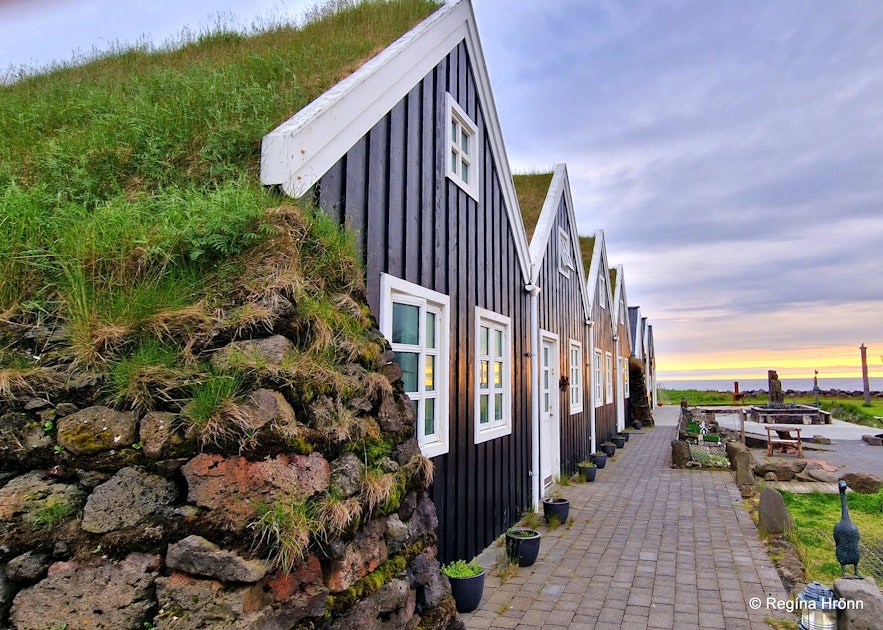 Beautiful Hlið
Beautiful Hlið
Jóhannes has added to the accommodation, turf house style, and his plan is to have one room in each gable.
At Hlið you will also find a restaurant in a separate building, where groups can dine in beautiful settings.
Check out Hlið on the webpage of the Viking Village.
Möðrudalur at Öræfi turf house
Möðrudalur at Öræfi turf house
In Möðrudalur at Öræfi in NE-Iceland, you will find the highest-located settlement in Iceland, right in the middle of nowhere, as it were.
At Möðrudalur you will find Fjallakaffi - a very popular oasis for travellers around Iceland, where you can get traditional Icelandic food. Möðrudalur farm also offers accommodation, both at the camping site and in latter-day turf houses, called Baðstofa - the sitting room of olden times.
Read more in my travel-blog:
Möðrudalur the highest-located farm in Iceland
Mánárbakki turf house in North-Iceland
Mánárbakki turf house in North-Iceland
On the Tjörnes peninsula in North Iceland, you will see a turf house at the Museum of Mánárbakki. It is a 3 gabled turf farm which houses parts of the museum.
In 1994 a house was moved from Húsavík to Mánárbakki to house the museum and the turf house was built.
Reykir turf house in North-Iceland
Reykir turf house in North Iceland
At Reykir in Skagafjörður in North Iceland, you will find a turf house, which was built in 1992 as a museum to the liking of a turf house, but with stone walls. It is relatively big, some 141.6 sq.m.
You can have a look at it from the outside, but it has stopped being a museum, due to a lack of visitors, the farmer told me.
Lýtingsstaðir in Skagafjörður - the Old Stable
Lýtingsstaðir in Skagafjörður in North Iceland - the Old Stable
The Old Stable at Lýtingsstaðir in Skagafjörður was built in 2015 as a museum. It is a horse stable and a storeroom, built of turf, stones and wood in the traditional way.
Check them out at Lýtingsstaðir.
Ingólfsskáli turf longhouse in South-Iceland

Ingólfsskáli turf longhouse in South-Iceland
Ingólfsskáli in South Iceland was built in 1998 to the liking of a Viking turf longhouse and named after Iceland's first settler, Ingólfur Arnarson. It is a private enterprise - kudos to the farmer and his family for building such a huge longhouse in honour of our first settler.
Ingólfsskáli has got timber-panelled concrete walls and outer walls made of turf. It got hit badly in a duplet earthquake - the bigger one being 6.3 on the Richter scale - back in 2008. The floors got rippled in the earthquake and some of the rafters broke like toothpicks!
Fortunately, the farmers were able to save it and Ingólfsskáli was rebuilt.
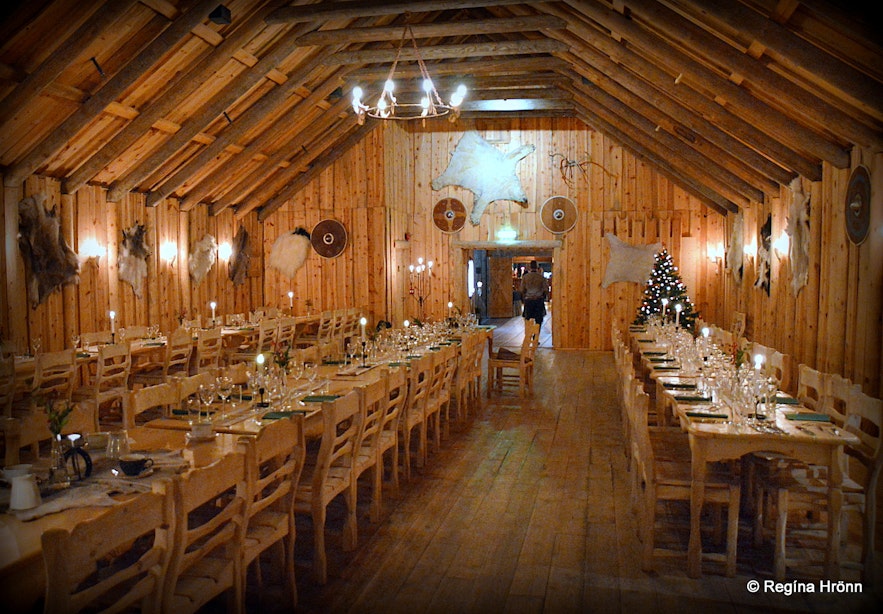
Ingólfsskáli turf longhouse in South-Iceland
Ingólfur Arnarson, who arrived in Iceland in around year 874, spent his 3rd winter by Mt. Ingólfsfjall on his way west in search of his high seat pillars.
He had thrown them overboard from his Viking ship when he spotted Iceland and swore to settle where the high seat pillars would drift ashore.

Ingólfsskáli operates as a Viking restaurant with an emphasis on Icelandic food - check them out on their homepage Ingólfsskáli.
See also my travel-blog:
The turf house at Efri-Vík by Landbrot in South-Iceland
The turf house at Efri-Vík by Landbrot in South Iceland
Hörður, the owner of the land at Efri-Vík by Landbrot in South Iceland and Hotel Laki, is building a turf house on his land with his family. They went on a course in turf house building and are building a turf house on their land to show to their visitors.
They don't want the old ways of building a turf house to be forgotten. Kudos to them I say :) I have stayed at their hotel twice and this is what the turf house looked like in September 2020.
See also my travel-blog:
Hotel Laki and its Amazing Surroundings in South-Iceland
Drangeyjarskáli on Drangey island in North-Iceland
Drangeyjarskáli on Drangey island in North Iceland in the fog
On Drangey island, where the Viking Grettir the Strong of the Saga of Grettir was killed in the year 1031, you will find a black and white painted turf house, Drangeyjarskáli hut. This turf hut was erected in 1984.
During my visit to the island, it was extremely foggy with low visibility, which gave all my photos an unwanted blue hue.
You can read more about the adventurous tour to Drangey island and Grettir the Strong in my travel-blog:
Drangey Bird Cliff in North Iceland and the Viking Grettir the Strong
Fishermen's turf huts
You will find old turf fishermen's huts in several places in Iceland:
Sjómannagarðurinn - the Fishermen's Garden
The Fishermen's Garden in West-Iceland
At the Fishermen's Garden in Hellissandur on the Snæfellsnes peninsula, you will find Þorvaldarbúð fishermen's turf hut. Þorvaldarbúð was the last lived-in fishermen's hut of the many fishermen's huts on the peninsula.
It has been restored and can be visited at the Fishermen's Garden, where you can see the living conditions of the Icelandic seasonal fishermen in olden times.
Read more about this turf fishermen's hut in my travel-blog:
The Fishermen's Garden in Hellissandur on the Snæfellsnes Peninsula
Þuríðarbúð fishermen's hut in South Iceland
Þuríðarbúð fishermen's hut in South-Iceland
Another well-known fishermen's hut is the hypothetical Þuríðarbúð in Stokkseyri village in South Iceland. This tiny turf hut is a replica of an old seasonal fishermen's hut. It was erected back in 1949 in memory of Þuríður Einarsdóttir (1777-1863) and the old ways of the seasonal fishermen in this area.
Þuríður was a remarkable woman; she started fishing on rowing boats with her father when she was only 11 years old and when she was 17 she had become an able-bodied seaman. She dressed as a man at sea and had to get a special permit from the sheriff to do so.
For the most part of her working years at sea, which lasted until 1843, she was a so-called formaður, which was remarkable for a woman at that time.
Inside Þuríðarbúð fishermen's hut in South-Iceland
Such fishermen's huts, made with turf, rock and wood, were to be found in many places in Iceland. Here the seasonal fishermen slept and ate together.
Two and two slept together, so it must have been strange being the only woman with all these men.
Þuríðarbúð was rebuilt in 2001. It is under the care of Byggðasafn Árnesinga - the Árnessýsla Heritage Museum and is open to visitors.
Ósvör Maritime Museum in the Westfjords of Iceland
Ósvör Maritime Museum in the Westfjords of Iceland
Another idyllic fishermen's hut is Ósvör in Bolungarvík in the Westfjords of Iceland, which is now a Maritime Museum. It is a very well-known photo model. Ósvör consists of a double fishermen's hut from the 19th century, a salt house and a fish-drying hovel.
Here you can also see the rowing boat, Ölver, which is a typical boat used for fishing in the olden days.
You will be greeted by a man dressed in the old traditional "skinnklæði", which the Icelandic fishermen used to wear at sea. I must say that he looks really authentic dressed in this way ;)

Ósvör maritime museum
Check them out at Ósvör Maritime Museum.
I have also written a travel-blog about Bollungarvík and Ósvör: Visiting Bolungarvík Village in the Westfjords of Iceland - the End of Road 61 Djúpvegur
Stekkjarkot workingman's cottage in SW-Iceland
Stekkjarkot workingman's cottage in SW-Iceland
In Njarðvík in SW-Iceland, you will find Stekkjarkot, 2 small turf houses, the older one built in the mid-19th century (1855-1857), and the newer one built at later stages.
Stekkjarkot was the last inhabited turf house in Njarðvík and was rebuilt in 1992 on the 50th anniversary of Njarðvík.
Stekkjarkot was a so-called þurrabúð - a workingman's cottage, made of timber, rock and turf. The cottage was built on another farmer's land and the occupants rented the cottage from the farmer. The tenants had to rely solely on fishing, as they were forbidden to keep domestic animals.
Stekkjarkot workingman's cottage in SW-Iceland
Stekkjarkot was built for fishermen and their families. Only 3 families lived in it from 1855-1924, but it was abandoned in 1887-1917, and restored and inhabited from 1917-1924 until it was abandoned again. Stekkjarkot was rebuilt in 1993.
Hjallur - the Shed in Vatnsfjörður in the Westfjords of Iceland
Hjallur - the Shed in Vatnsfjörður in the Westfjords of Iceland
Belonging to the Historical Buildings Collection of Þjóðminjasafnið - the National Museum of Iceland - is the fish-shed Hjallur - the Hovel, in Vatnsfjörður on the northern part of the Westfjords of Iceland.
Hjallur was built around 1880 from timber and rocks and has got a turf roof. It was restored by the National Museum of Iceland in 1976 and preserved that year. Such sheds were mainly used for keeping fishing gear and for drying fish.
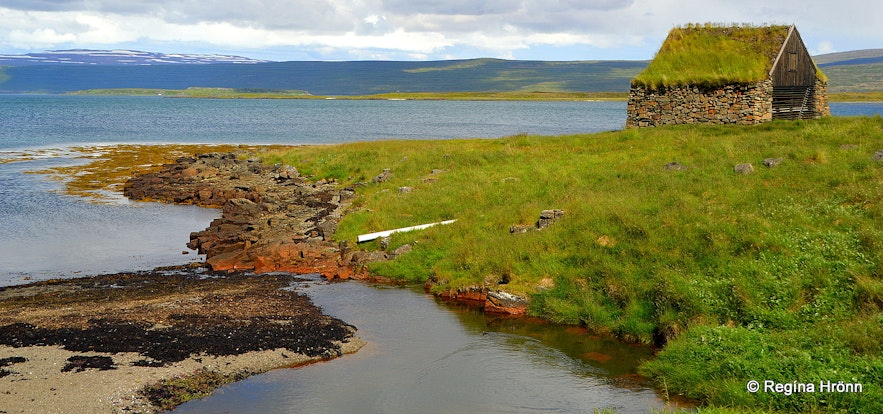
Hjallur - the Shed in Vatnsfjörður in the Westfjords of Iceland
Hjallur is open to visitors. Let's always treat these old turf structures with utter respect as they are delicate gems.
You can read more about the historical Vatnsfjörður in my travel-blog Vatnsfjörður in the Westfjords of Iceland - the Viking Estate and Grettisvarða Cairn.
Outhouses made of turf
All over Iceland, you will still find a lot of turf outhouses, many of which have become really dilapidated.
The turf lamb houses at Keldur in South-Iceland
Turf houses need a lot of maintenance, and Helgi at Fornverkaskólinn, who is in charge of maintaining the turf houses all over Iceland, once told me that it would be too costly and time-consuming to maintain all the turf outhouses and that some of them will not make it, so to speak.
Several of them are well-maintained though and I am going to show you some of the well-maintained ones, which I have visited on my travels in Iceland. In my photo above you will see the cute turf lamb houses at Keldur, erected in 1883.
First I am going to show you the oldest remaining turf outhouse in Iceland:
The oldest turf outhouse in Iceland - Hesthúsið á Hólum in the Westfjords
The oldest turf outhouse in Iceland - Hesthúsið á Hólum in the Westfjords
The oldest turf outhouse in Iceland is to be found in the remote Kollsvík in the Westfjords of Iceland. It is a small stable made of turf and rocks and dates back to 1650! It might even be older.
You can see the turf outhouse to the left in my photo above. The surroundings are so beautiful in the Westfjords that I had to show you what this cove looks like. If you look closely at the photo you will see two other turf outhouses further away.
Inside the oldest turf outhouse in Iceland - Hesthúsið á Hólum in the Westfjords
This, the oldest outhouse in Iceland, is called Hesthúsið á Hólum or the Stall at Hólar, but Hólar was the name of the farm. From 1944 this old stall was used as a smokehouse for male lumpfish and meat.
In 2010 the locals rebuilt the stall and it is now open to visitors. The whole area of Kollsvík is very well maintained and in this remote part of the Westfjords, you will see information signs in many places. Kudos to them for a job well done!
A turf outhouse at Kollsvík in the Westfjords of Iceland
This beautiful little turf outhouse is also to be found at Kollsvík, it is the same turf outhouse which can be seen really far away in my photo above. Isn't this a pretty photo?
I have written a travel-blog about Kollsvík: A Visit to Kollsvík Cove in the Westfjords - the smallest Settlement in Iceland
Langhús turf outhouses in East Iceland
Langhús turf outhouses in East-Iceland
In Fljótsdalur in East Iceland I visited the only turf outhouses which are still in use, to my knowledge, Langhús. The huge turf outhouses at Langhús are still used to keep sheep in the wintertime, which makes them very special indeed.
I knocked on the doors of the farmer at Langhús, Baldur Hjaltason, but he was not at home. I had a look around and hope he doesn't mind me posting photos of his amazing turf outhouses in my travel-blog.
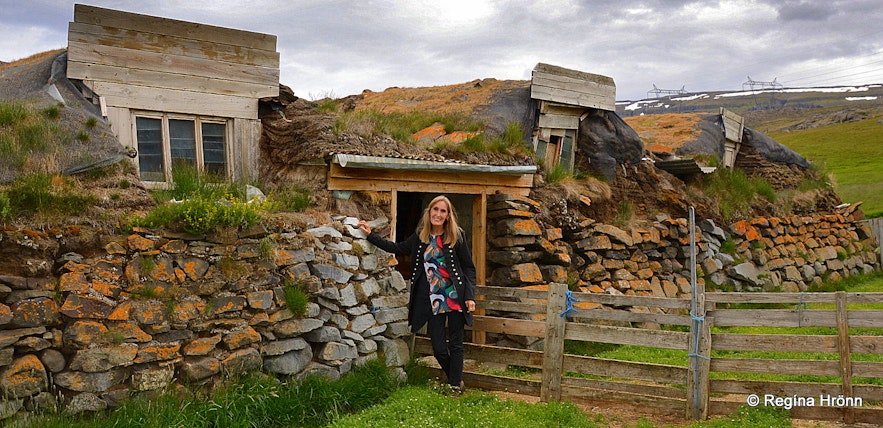
Langhús turf outhouses in East-Iceland
Seeing that I search for turf houses on my travels around my country, I was in awe when I checked out the huge turf houses at Langhús.
Never have I seen such huge turf outhouses. The outhouses in my photos are the main ones, but there are several other turf outhouses on the land of Langhús.
These turf outhouses are more than a hundred years old, but seeing that turf houses need constant maintenance, then the lower parts of the turf outhouses are much older.
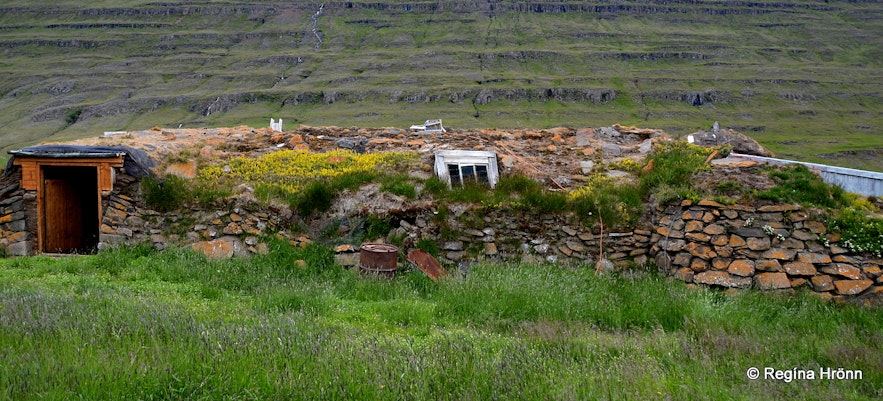 When the sheep disease scrapie showed its ugly face in Fljótsdalur, the whole stock of sheep in the valley had to be killed and the outhouses disinfected. Many of them were demolished as it was easier than disinfecting them, but not the outhouses at Langhús.
When the sheep disease scrapie showed its ugly face in Fljótsdalur, the whole stock of sheep in the valley had to be killed and the outhouses disinfected. Many of them were demolished as it was easier than disinfecting them, but not the outhouses at Langhús.
I am very glad that they were able to save them so that we, and future generations, can see what turf outhouses in Fljótsdalur valley looked like.
Torfhúsin á Hjarðarhaga - the turf houses of Hjarðarhagi farm in East Iceland
Torfhúsin á Hjarðarhaga - the turf houses of Hjarðarhagi farm in East-Iceland
I visited another set of turf outhouses in East Iceland at Hjarðarhagi farm in Jökuldalur valley. There you will find 2 turf outhouses remaining out of a cluster of 7 outhouses.
These big turf outhouses were in use until the 1970's when 5 of them were demolished when the road was built. I am glad that they kept 2 of the sheep outhouses to show us, Miðhús and Efstahús. They are sheep barns and the walls are made of rocks with turf on top and brushwood and turf in the ceiling.
They are in "original" form, keeping in mind that turf houses need constant maintenance, but all the later additions have been removed.

Torfhúsin á Hjarðarhaga - the turf houses of Hjarðarhagi farm in East-Iceland
These turf houses are now under the supervision of the Cultural Heritage Agency. To visit them you can stop by an information sign right by the road by the farm Hjarðarhagi and have a look at them.
A selection of the remaining turf outhouses in Iceland
Hlíðartúnshúsin turf outhouses in Borgarnes town in West-Iceland
My photo above is of Hlíðartúnshúsin turf outhouses in Borgarnes town in West Iceland, which were built in 1919 and have been restored in the past few years.
They consist of sheep barns, a cowshed, a barn and a potato shed.
Turf outhouses at Staður in the Westfjords of Iceland
I saw this well-maintained turf outhouse (photo above) at Staður In Austur-Barðastrandasýsla on the southern part of the Westfjords of Iceland. It is located some 8 km west of Reykhólar.
It is so well-maintained that it looks like a museum.
Turf outhouses at Vallarhjáleiga in Flóahreppur in South-Iceland
These brightly blue-painted turf outhouses I found at Vallarhjáleiga in Flóahreppur in South Iceland, but a relative of mine owns this land.
This is the only outhouse I have seen in Iceland painted in this bright blue colour :)
A turf outhouse in Svarfaðardalur in North-Iceland
Located up on a hill deep in the valley of Svarfaðardalur in North Iceland you will see a privately owned turf outhouse, which has been repaired by Helgi (photo above).
A turf outhouse in Stokkseyri in South-Iceland
This cyclops turf house I found by the main street in Stokkseyri village in South Iceland, the same village where Þuríðarbúð fishermen's cottage is located.
This is Garðhús from 1890, rebuilt in 1916 (Minjastofnun page 22-27) and is a typical example of a workingman's cottage with outhouses. From what I gather there is an open-hearth kitchen in this turf house. The trees have grown so much since I took this photo that it can barely be seen from the road.
Be on the look-out for turf outhouses, you never know when you are going to spot one :)
Turf outhouses at Kálfafellskot in South-Iceland
The above turf outhouses are also to be found in South Iceland, by the farm Kálfafellskot. They are adjacent to the newer farm (1931) and consist of a dairy barn, a stable and a storehouse, which was also used as a sheep barn.
These turf outhouses are made of driftwood, slab, turf and rocks.
Turf outhouse at Dalshöfði farm in South-Iceland
Not far from Kálfafellskot in South Iceland, at Dalshöfði farm you will find another lovely turf outhouse, built for farm animals. T
he turf outhouse closer to us in the photo was built in 1957 or 1958 and the adjacent turf outhouse further away was built in 1970, both of them with the traditional building methods of turf, wood and rocks.
The owners of Dalshöfði run a small guesthouse on their farm. I visited Dalshöfði at Easter when we had quite a lot of snow, but the turf houses look so lovely in the snow, don't you think?
The turf outhouse by Mt. Lómagnúpur in South-Iceland
The last turf outhouse I am going to show you is this big turf outhouse, an old barn which belongs to Núpsstaður. It is located some distance away from the farm and has become dilapidated.
When I met Helgi at Fornverkaskólinn at Þverá turf house in North Iceland, where he was rebuilding the outhouses at Þverá, he told me about this large outhouse by Mt. Lómagnúpur. If you visit it be very careful.
Miscellaneous turf structures
On my travels around Iceland, I have visited some turf houses, which don't fall into the categories, I have mentioned above.
Steingrímsfjarðarheiði turf hospice in the Westfjords of Iceland
Steingrímsfjarðarheiði turf hospice in the Westfjords of Iceland
On Steingrímsfjarðarheiði heath in the Westfjords of Iceland, you will notice a small turf house a short distance away from the road. Far enough away though to look like a hobbit house in the distance.
I had passed it several times before I decided on stopping and checking it out.
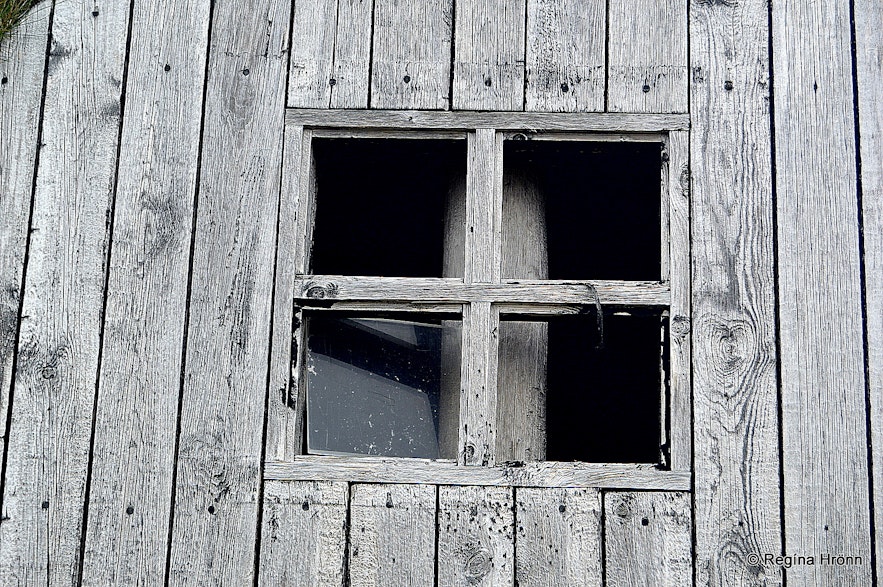
Steingrímsfjarðarheiði turf hospice in the Westfjords of Iceland
It is an old hospice - sæluhús in Icelandic, built in 1923 and rebuilt in 1989 by the Lions club in Hólmavík. You will see several hospices on the heaths in Iceland, new and old. This old hospice is made out of turf, rocks and driftwood, but there is plenty of driftwood at Strandir in the vicinity.
Kofinn - the Shed at Sauðhúsvöllur in South-Iceland
Sauðhúsvöllur turf shed in South-Iceland
At Sauðhúsvöllur in South Iceland, you will notice a small turf shed by ring-road 1. It is called Kofinn - the Shed. It is a typical shed made at the time when cars arrived in Iceland.
This shed was made in 1948 by the farmer Sigurður Guðjónsson and his son Magnús Sigurðsson and was in use until 1963.
Such sheds were shelters for people waiting for buses and shelter for milk cans for the milk truck. It is reconstructed and while my father-in-law, Jakob Hálfdanarson, was working for Vegagerðin - the Road Administration of Iceland, he was in charge of reconstructing this turf shed.
I am glad that this was done and that the turf shed wasn't lost.
Tumbi in the highland of Iceland
Tumbi hut in the highlands of Iceland
In the highland of Iceland, you will come across a small hut made out of rock with a corrugated iron roof and a birch tree on top. This little hut is called Tumbi (Miðfellskofi or Fellnakofi).
It was erected sometime between 1925-1930 by the farmers of the Mývatn area as a shelter for the shepherds searching for sheep in the highlands.
You can read more about it in my travel-blog:
An Amazing Tour to Askja and Holuhraun Lava Field in the Highlands of Iceland
The turf mill house at Keldur in South-Iceland
At Keldur turf house in South Iceland, you will find this 120-year-old cute little turf mill house (photo above), which is located down by the Króktúnslækur creek and runs on hydroelectric power.
A turf house at Hveravellir in the highland of Iceland
This hut (photo above), which is made of turf, rocks and driftwood is located in Hveravellir in the highlands of Iceland.
And the dilapidated turf house (photo below) I encountered on my travels while driving on a smaller road just before I reached the Snæfellsnes peninsula.
A dilapidated turf house in West-Iceland
In Laugardalur valley in Reykjavík, you will see a turf shed half-hidden away in between the trees (photo below).
In my travel-blog about Laugardalur, you will see winter photos of the turf house in Laugardalur, but the turf houses look very lovely with snow on top.
Laugardalur turf shed in Reykjavík
In Hjaltidalur valley in North Iceland at the farm Efri-Ás, the farmer Árni Sverrisson and his wife and friends built a Ásatrúarhof in 2010-2014.
The consecrated heathen temple is built to the liking of the old places of worship that the early inhabitants of Iceland built to worship the old Nordic gods before the Christianization of Iceland in the year 1.000.
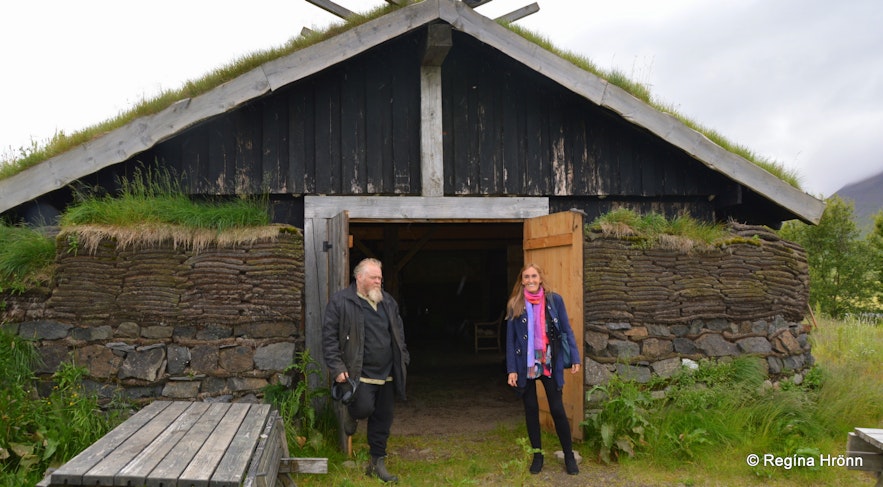 Árni showed us the hof that he built on his farm
Árni showed us the hof that he built on his farm
Árni is the Chieftain of Hegranes (Hegranesgoði) and follows the old Norse faith.
He and his wife, Heiðbjört Hlín, run a large dairy farm at Efri-Ás with many cows, horses and sheep, but Árni took the time from his busy schedule to show us around the hof, which is around 70-80 sq.m.
 Yggdrasill, the sacred tree, is carved on the door of the hof at Efri-Ás
Yggdrasill, the sacred tree, is carved on the door of the hof at Efri-Ás
There are several other turf structures, which I haven't mentioned here in this travel-blog. In Álftaver in South Iceland, you will see a sauðahús in the possession of the National Museum of Iceland - see photos here.
I tried finding these turf outhouses in April 2018, but couldn't, so I am going to join a guided tour from the farmers at Nonna and Brynjuhús soon.
In Fljótshlíð in South Iceland, we have Meyjarhofið turf house, which was erected in honour of women back in 2007. I haven't visited it yet, but you can see some photos here.
And in 2018 a turf house retreat was opened in Biskupstungur in South Iceland. The houses resemble Saurbæjarkirkja turf church.
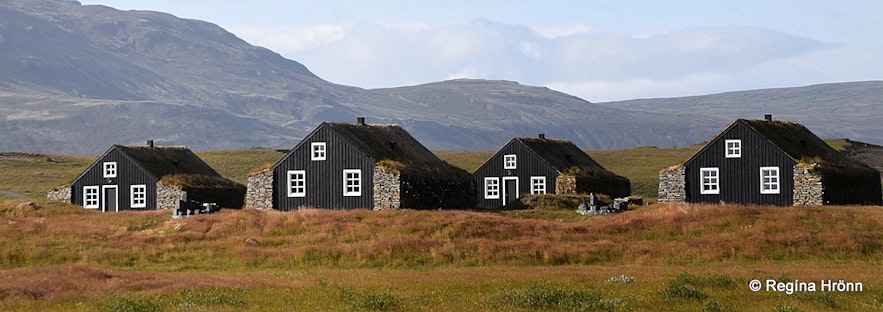
The Turf house retreat
Now, this is my take on the beautiful turf houses in Iceland, for which I have had a life-long passion. But as I have mentioned earlier in my travel-blogs, then I am just a layman travelling around my country, and not a professional in any way, so please correct me if you see any mistakes in my travel-blogs.
You can also check out what UNESCO has to say about the Icelandic turf houses, which is a more professional approach.
Þverá turf house
You will for sure see some turf houses on your travels in Iceland and I hope that this list will help you identify them. Also, see how many turf outhouses you can spot in the landscape. The original turf houses are delicate though and cannot withstand too much traffic, so we must preserve them the best we can.
I have also written another travel-blog about Viking Ruins and Burial Mounds I have visited on my Travels in Iceland - which is a list of all the archaeological sites and burial mounds, I have visited in Iceland.
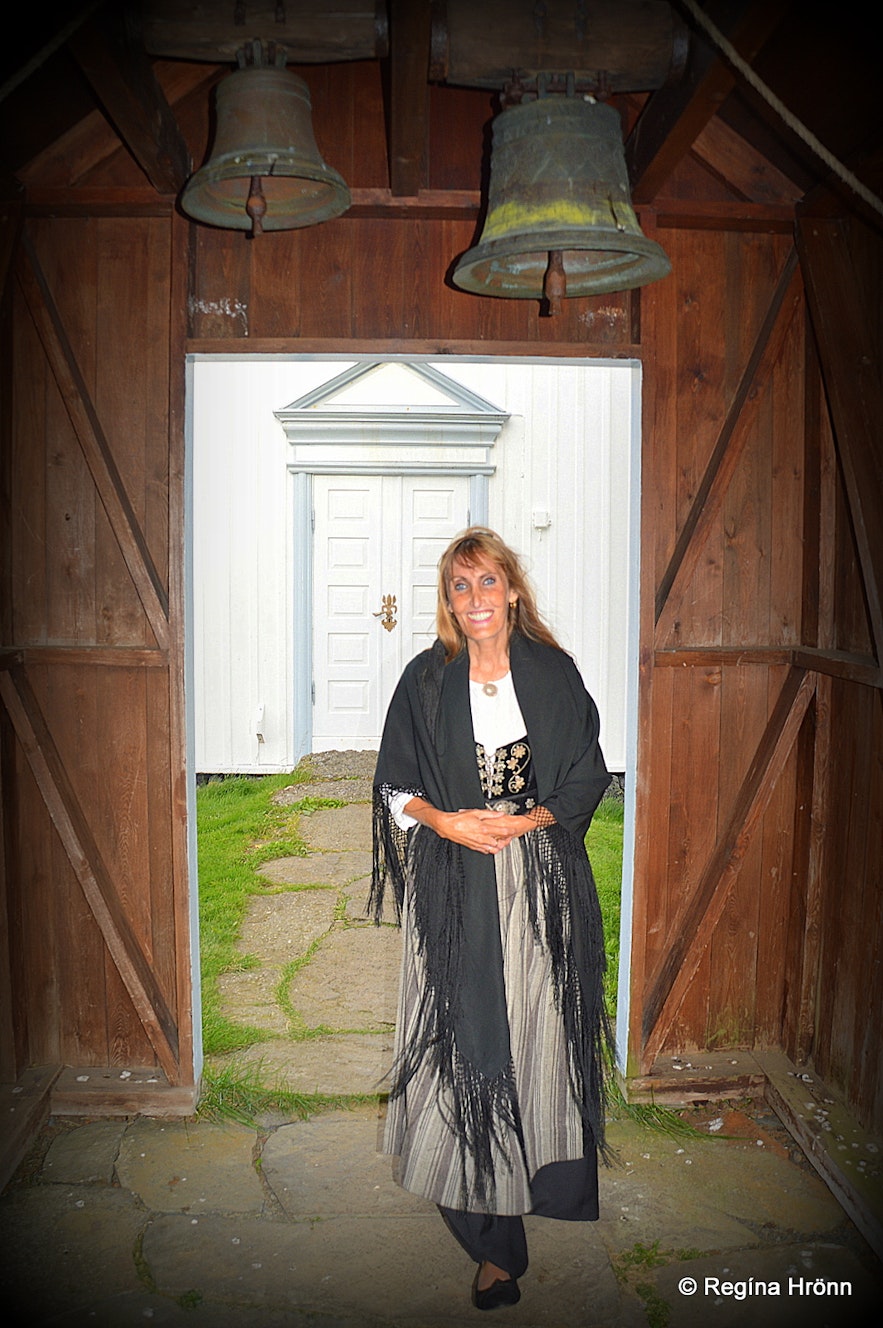
The lychgate and old bells at Grenjaðarstaður
Have a lovely time in Iceland :)
Sources:
Þjóðminjasafn Íslands - the National Museum of Iceland - Húsasafn
Af jörðu - íslensk torfhús - Hjörleifur Stefánsson
UNESCO - the Turf house tradition
Barmar - torfbær í Reykhólasveit - Morgunblaðið
Other interesting blogs
Chasing Waterfalls in Iceland
Iceland is spectacular in so many ways and Icelandic nature is quite unique with its vast landscape, volcanic activity, geothermal areas, glacier lagoons and sceneries, black sand beaches and spectRead moreSænautasel Turf House in the Highland of Iceland
In my search for turf houses around Iceland, I visited Sænautasel, which is a rebuilt turf house on Jökuldalsheiði heath in the highland of Iceland. It is, in my opinion, an extremely cute turf hoRead moreThe Dynamic Plant Lupine
People have been asking me where to find lupines in Iceland. If you like them you should be able to find them easily in Iceland in summer. They are in bloom and visible almost wherever you drive aroRead more

Download Iceland’s biggest travel marketplace to your phone to manage your entire trip in one place
Scan this QR code with your phone camera and press the link that appears to add Iceland’s biggest travel marketplace into your pocket. Enter your phone number or email address to receive an SMS or email with the download link.


